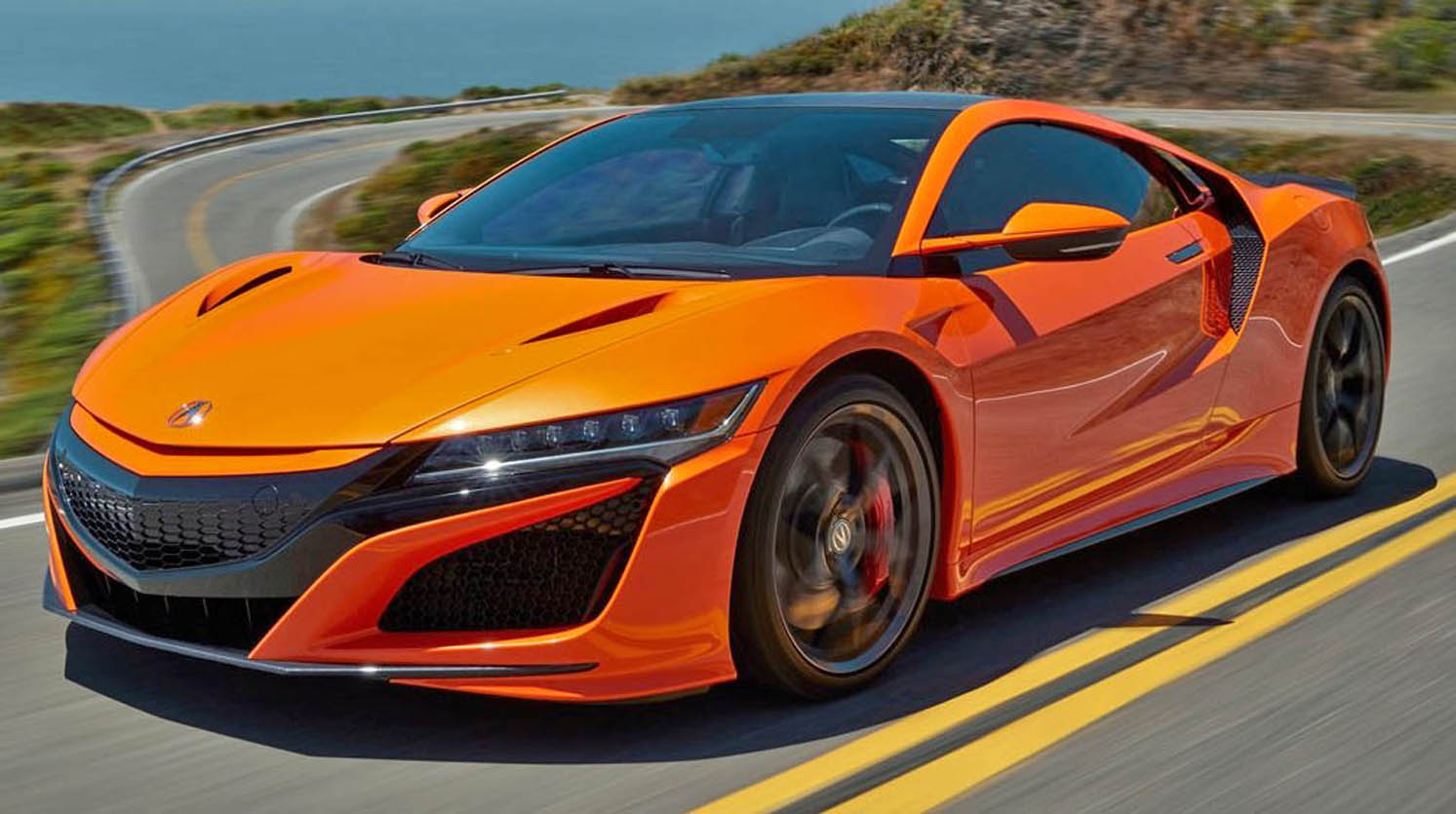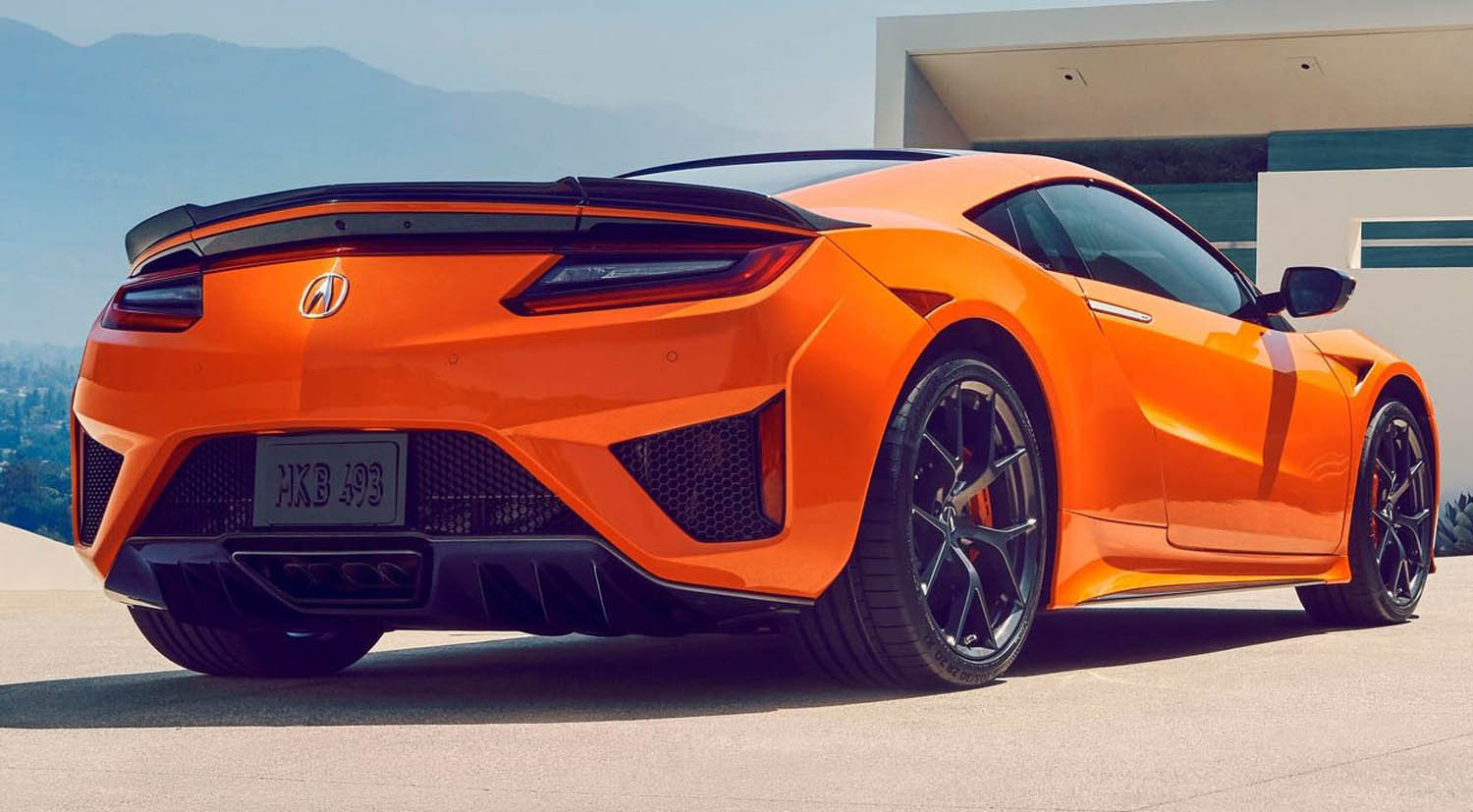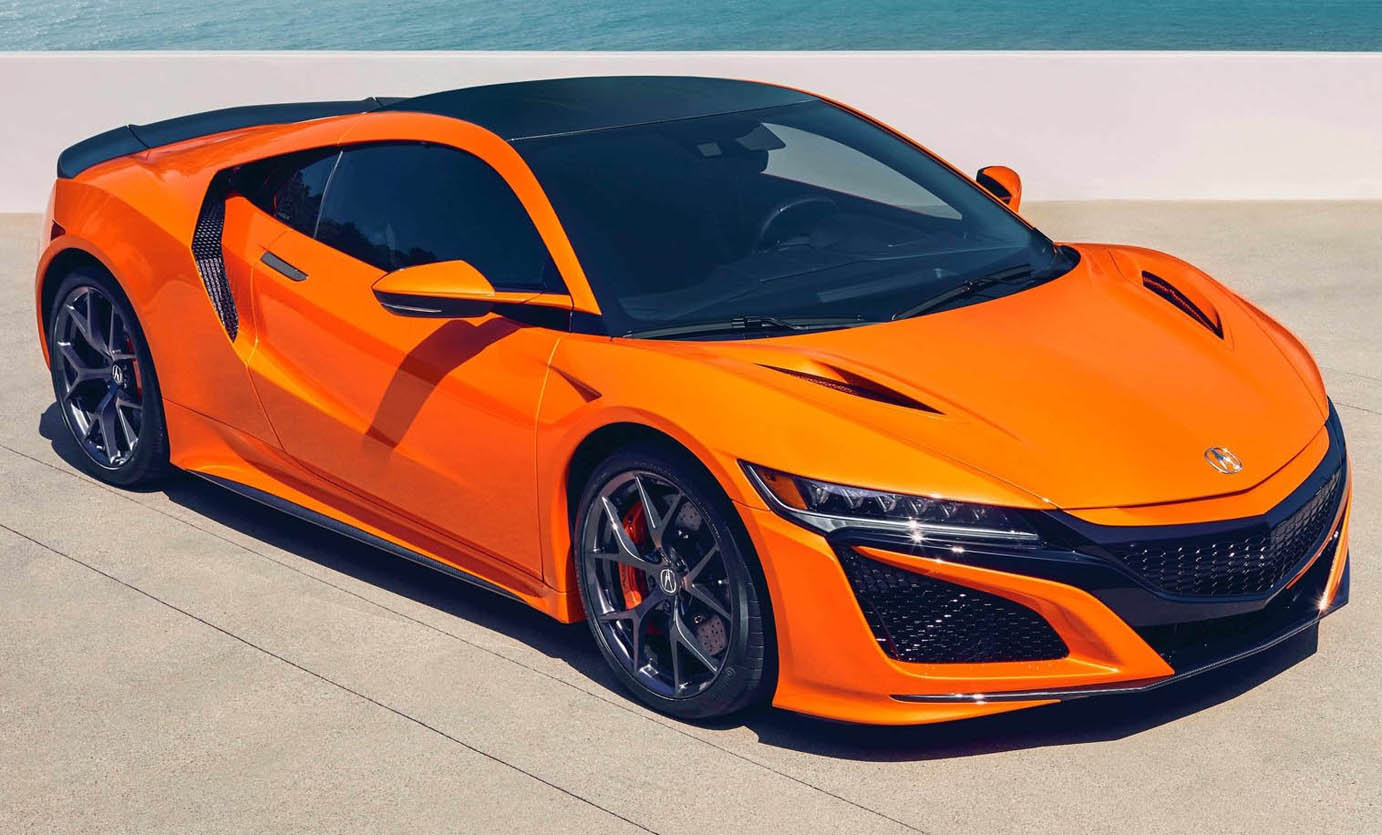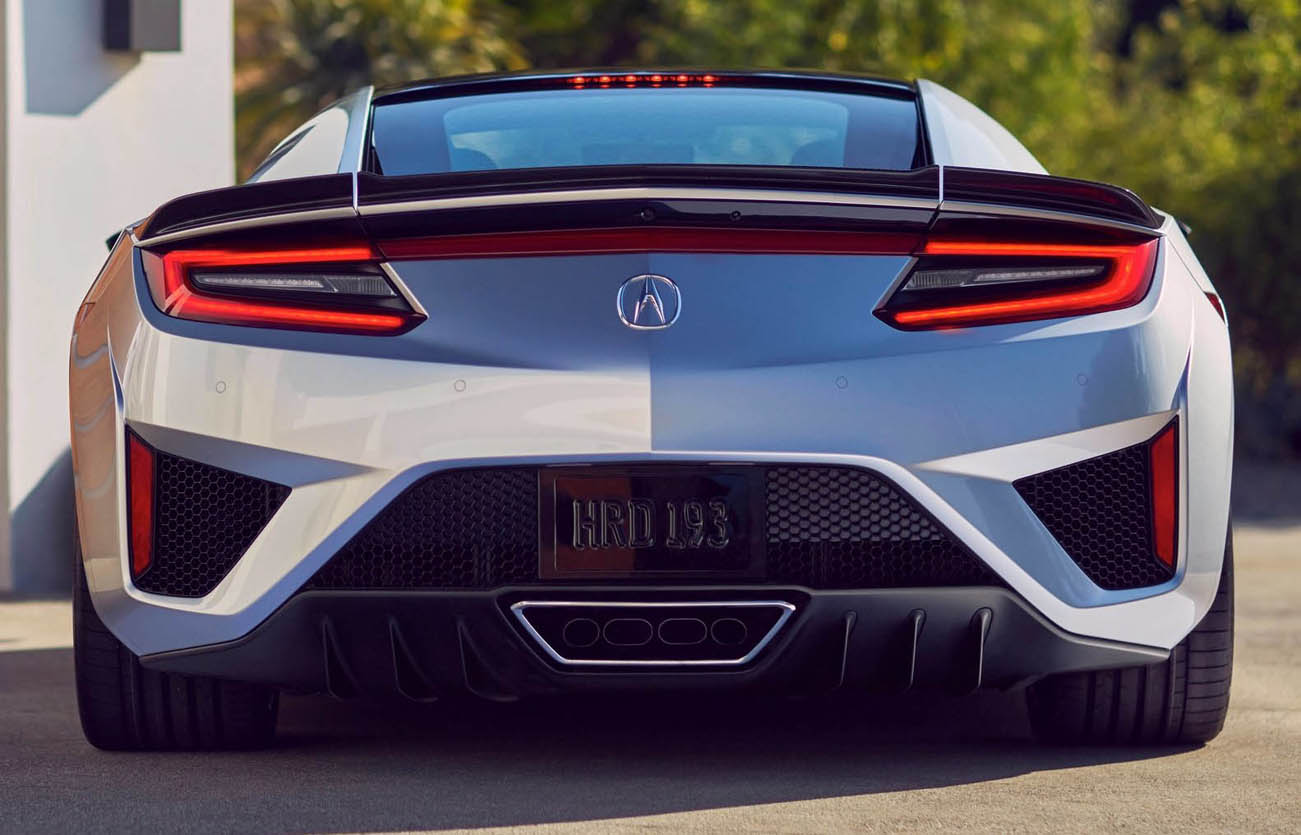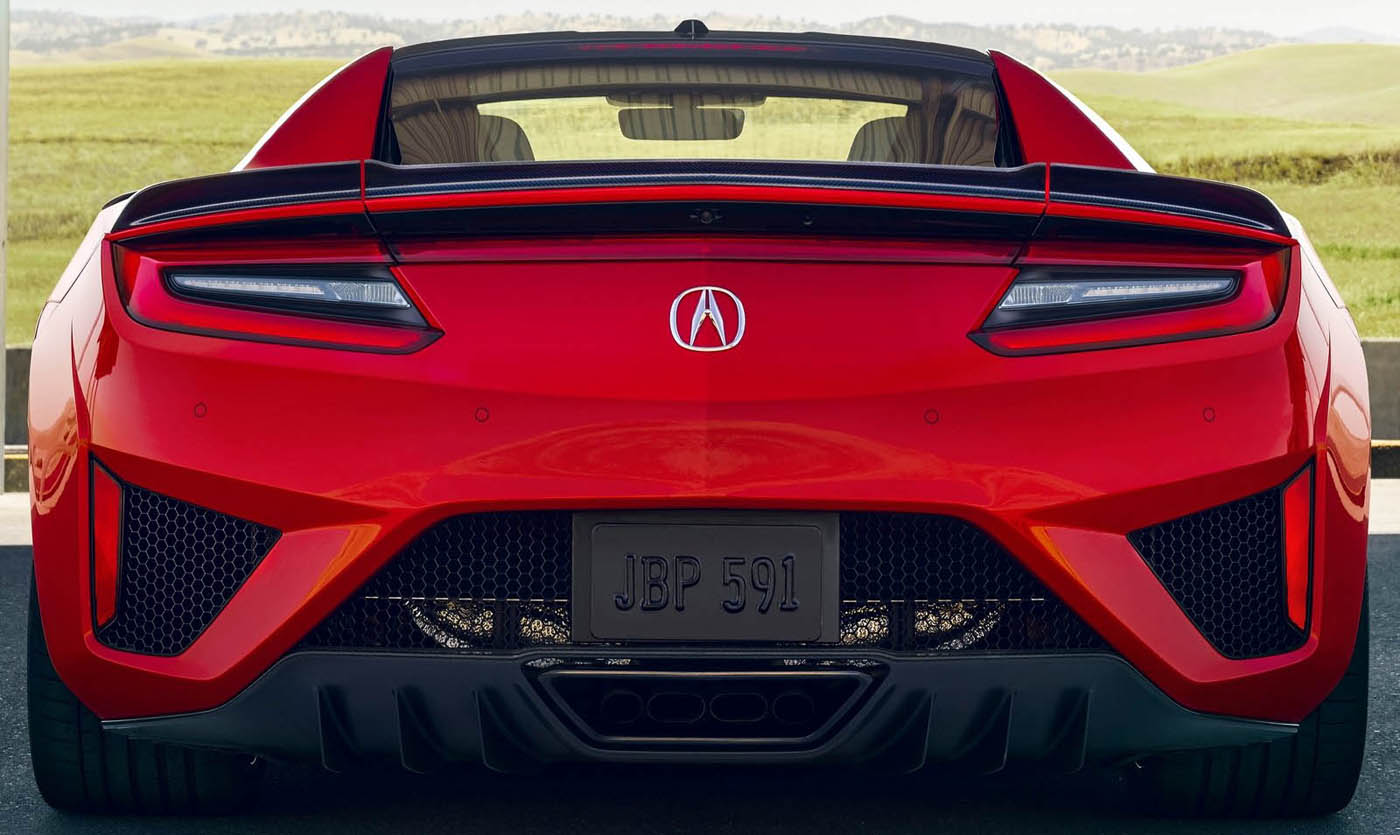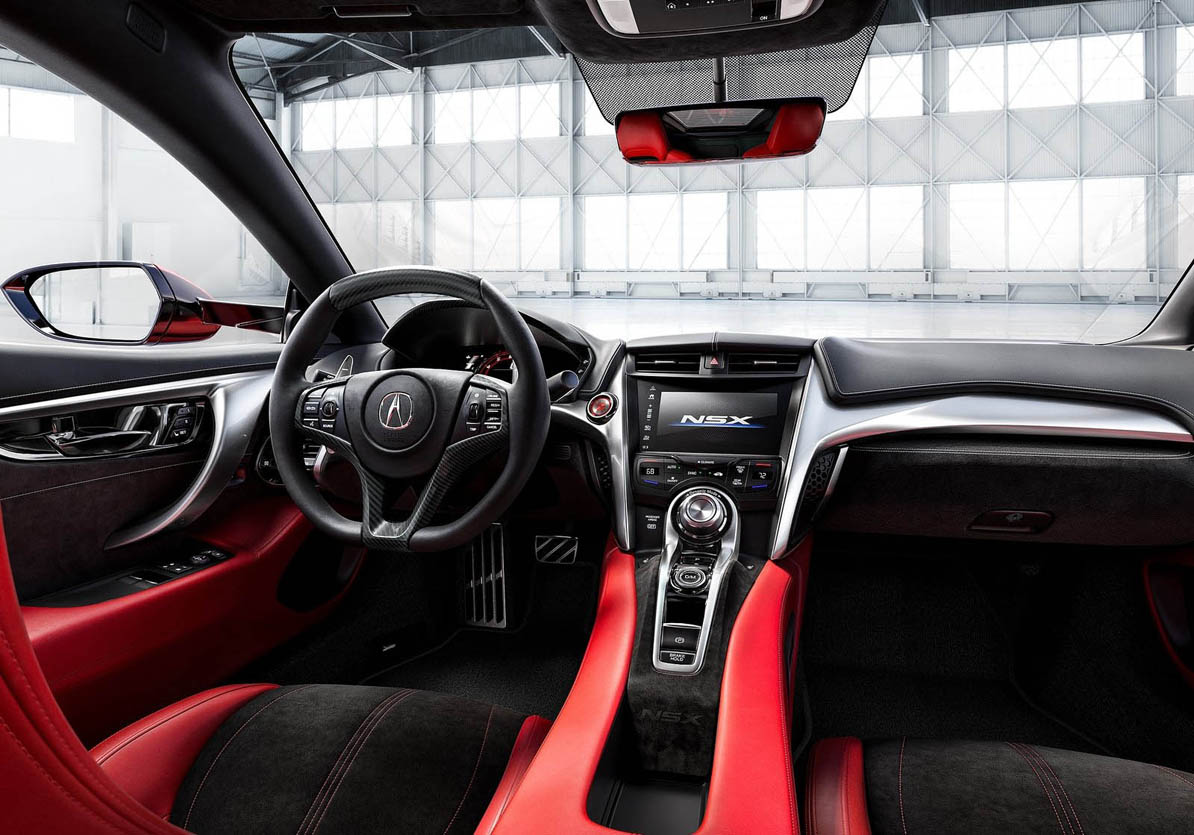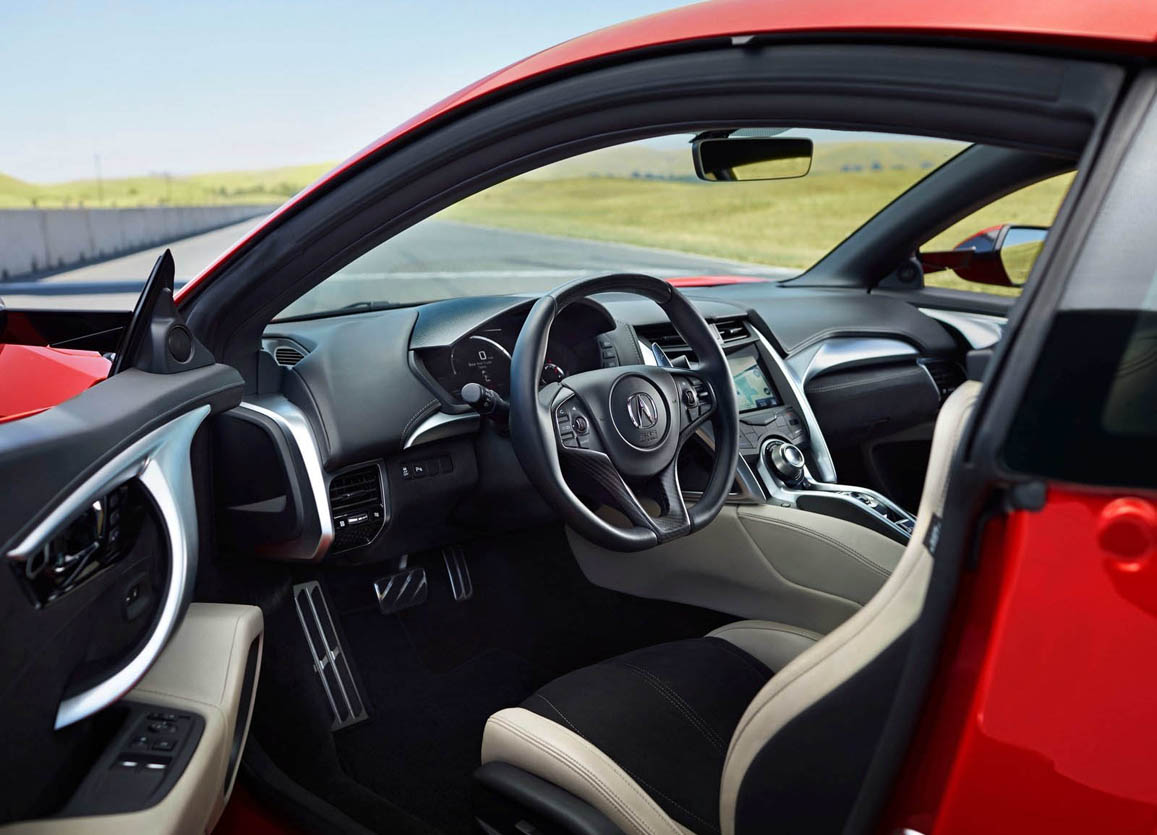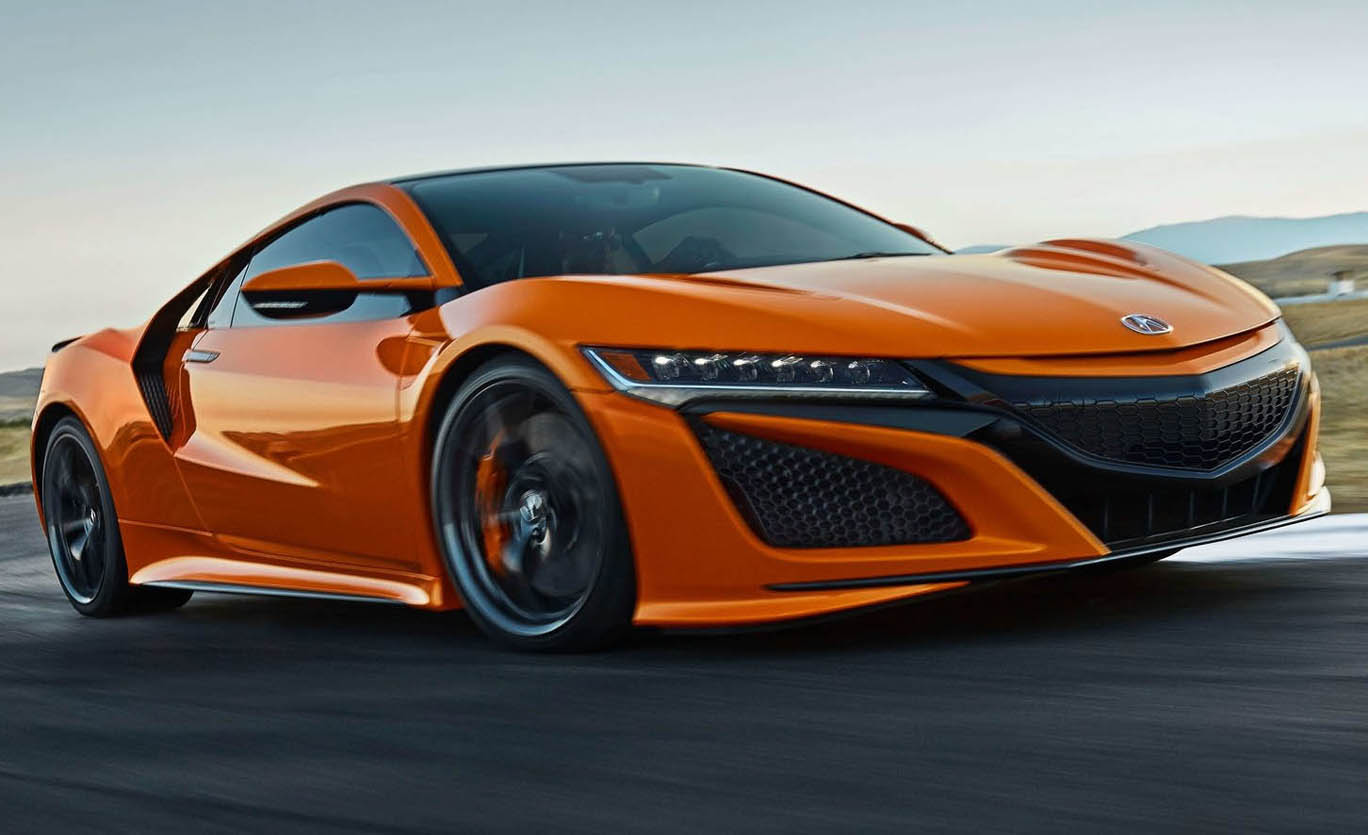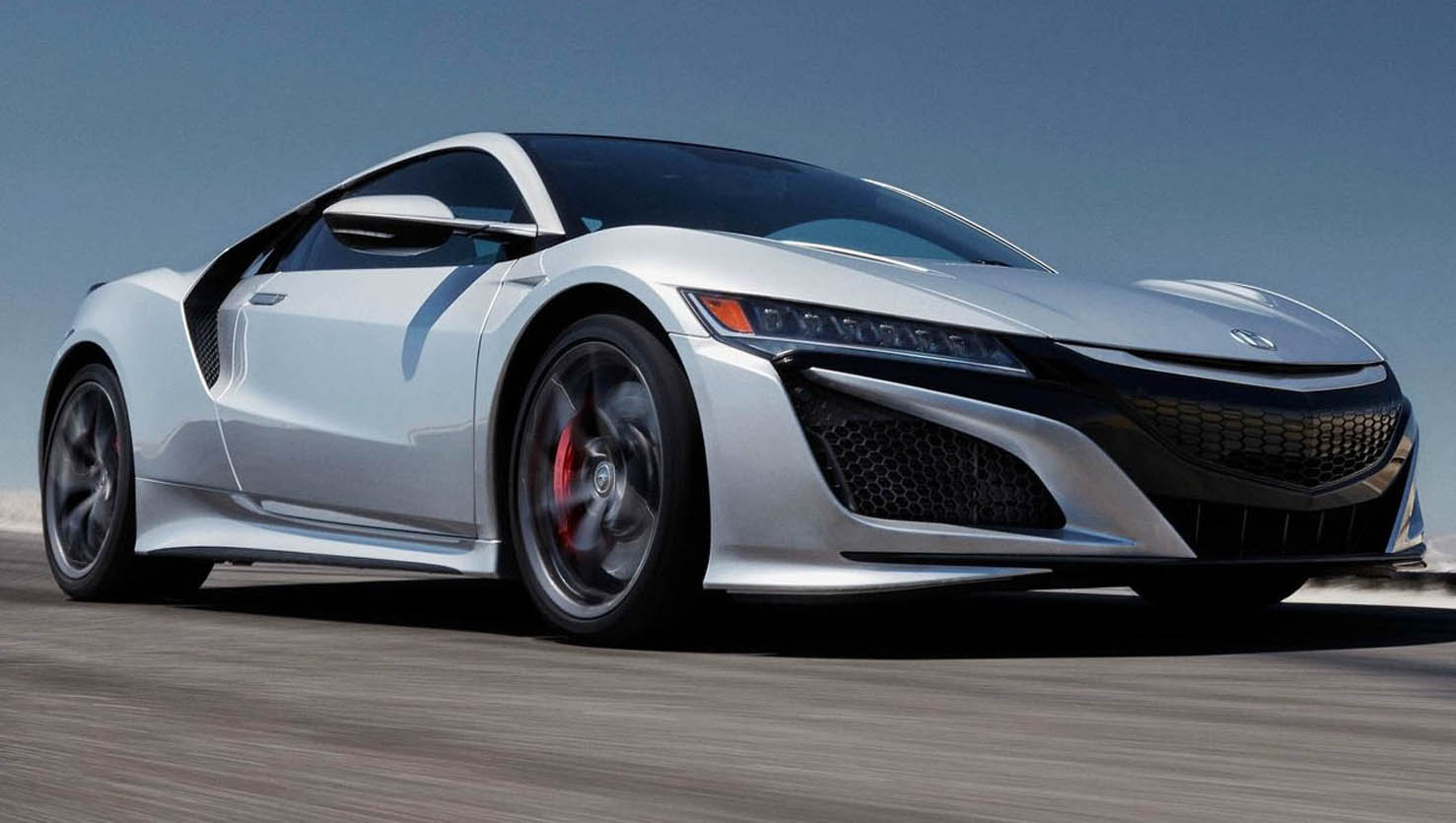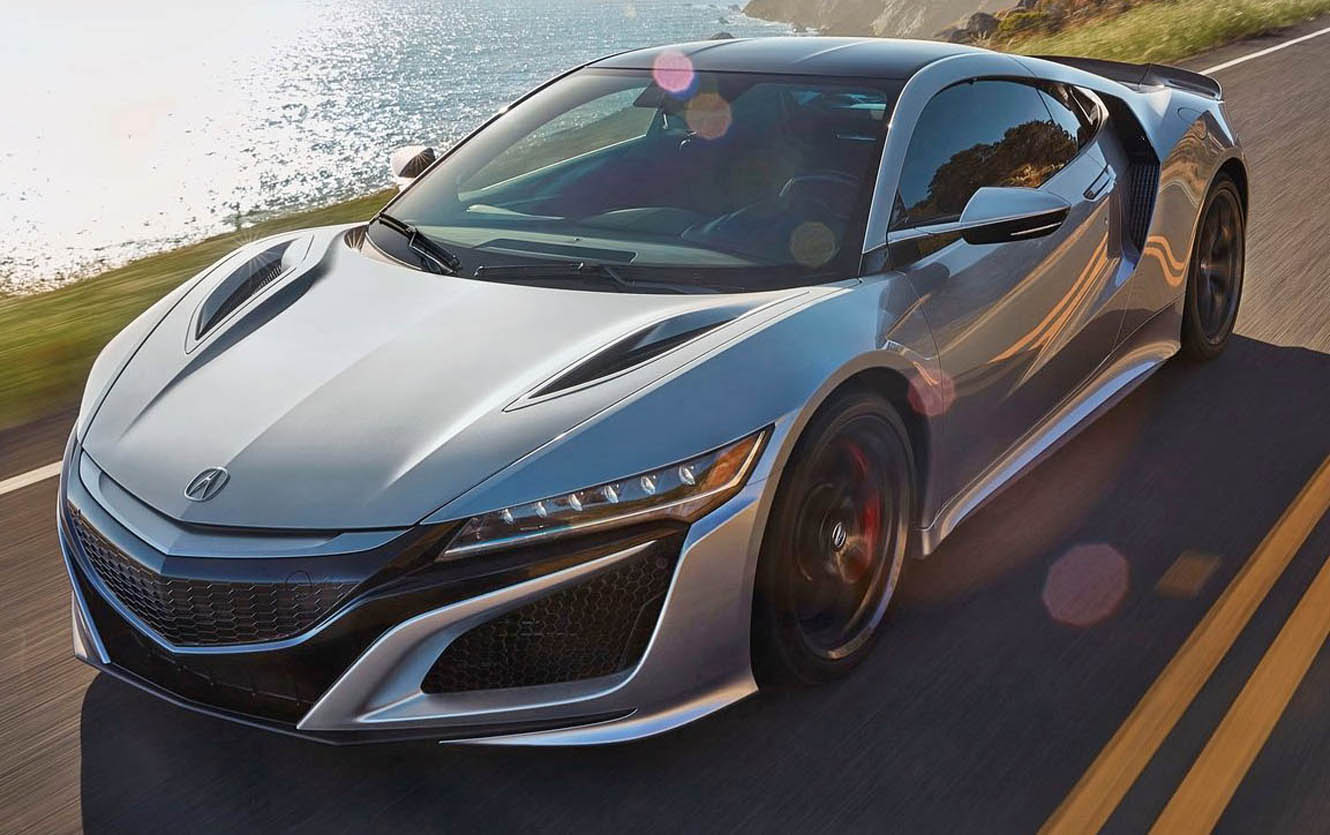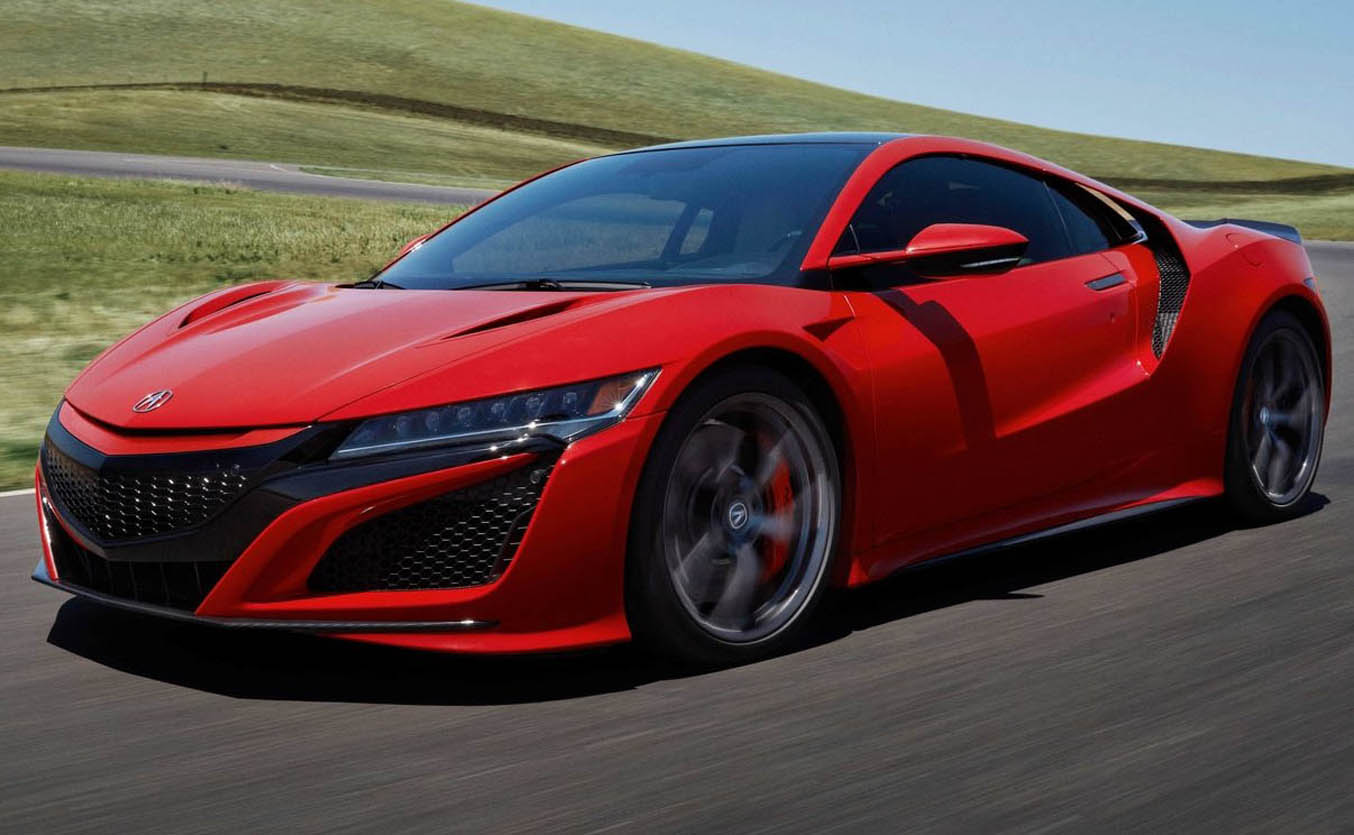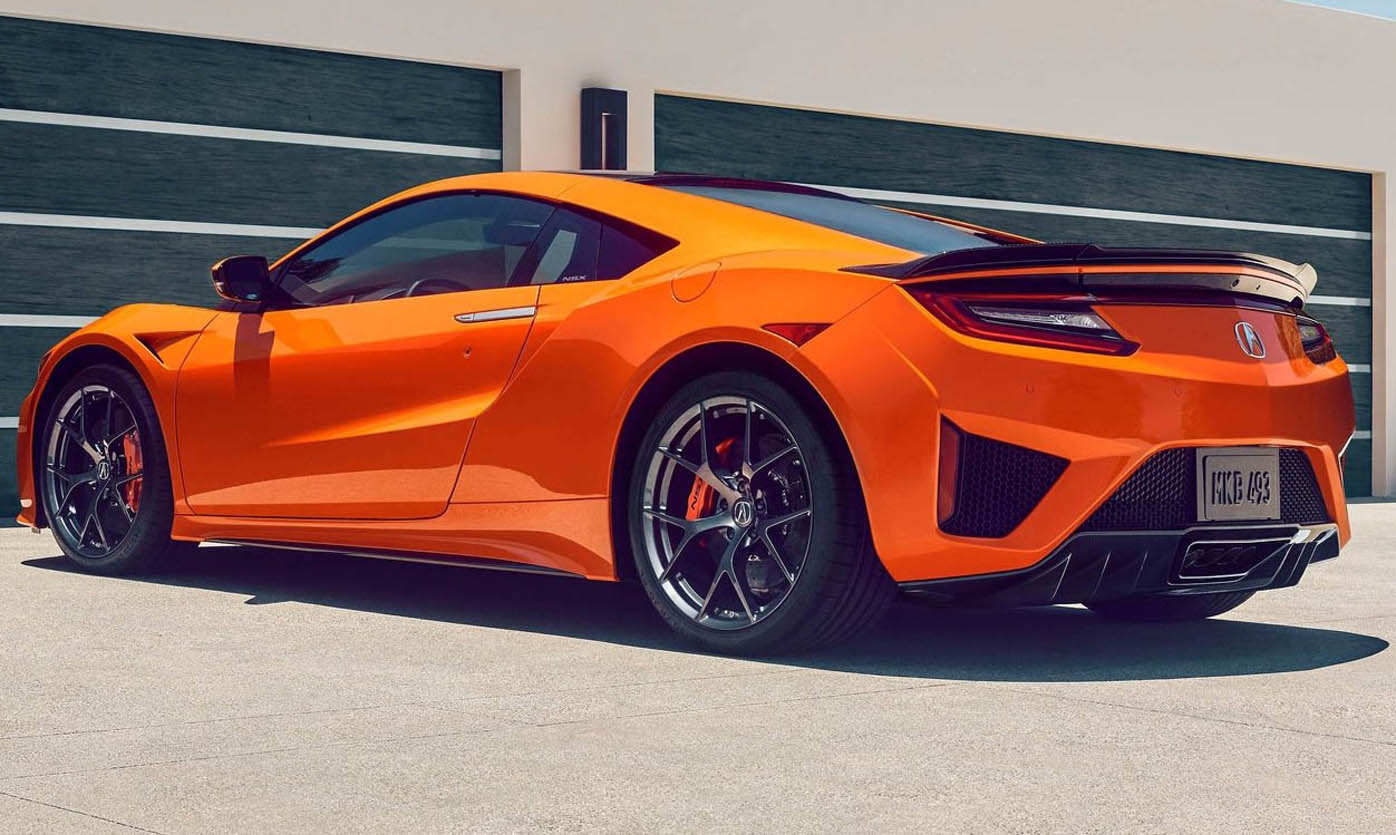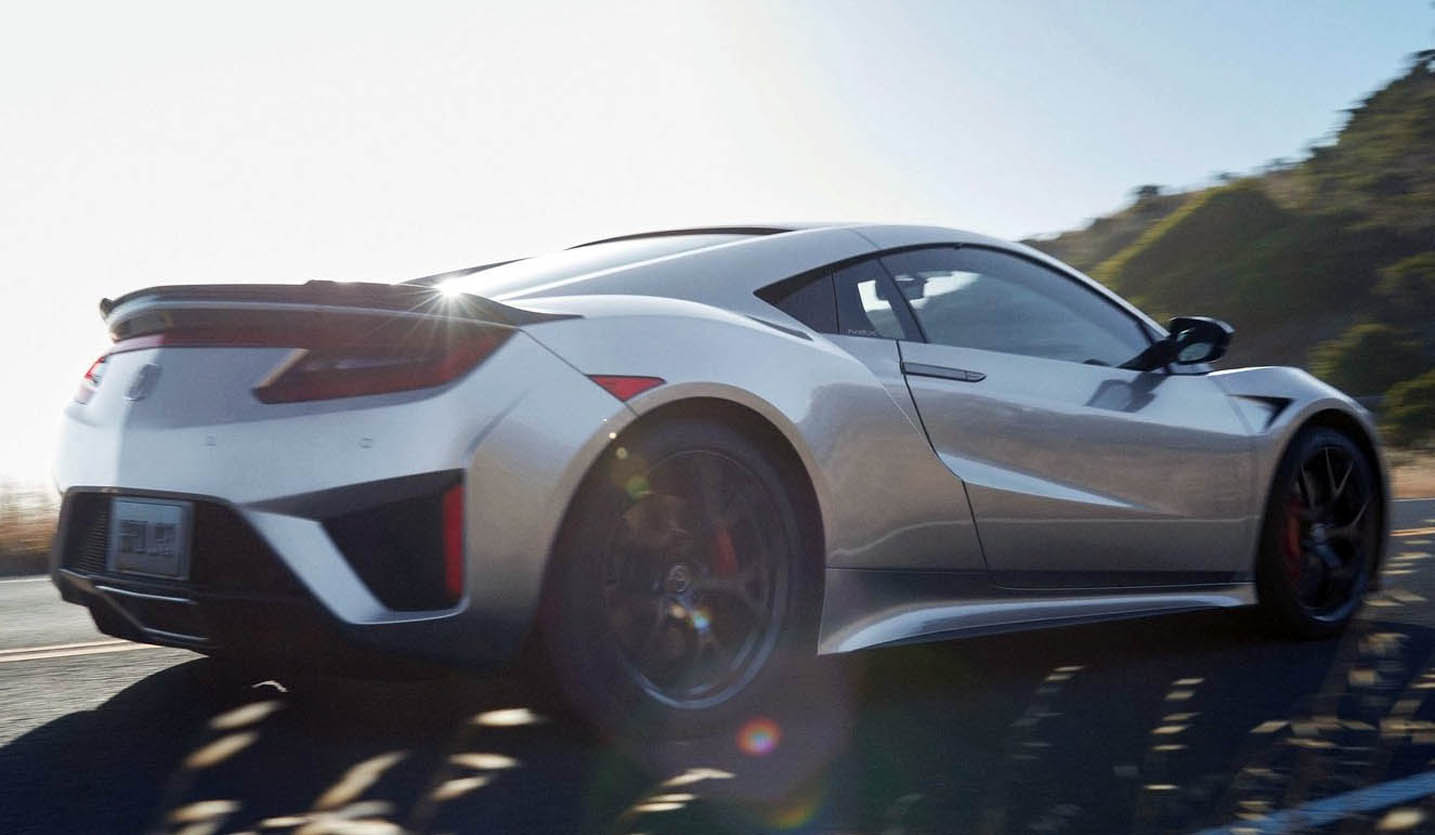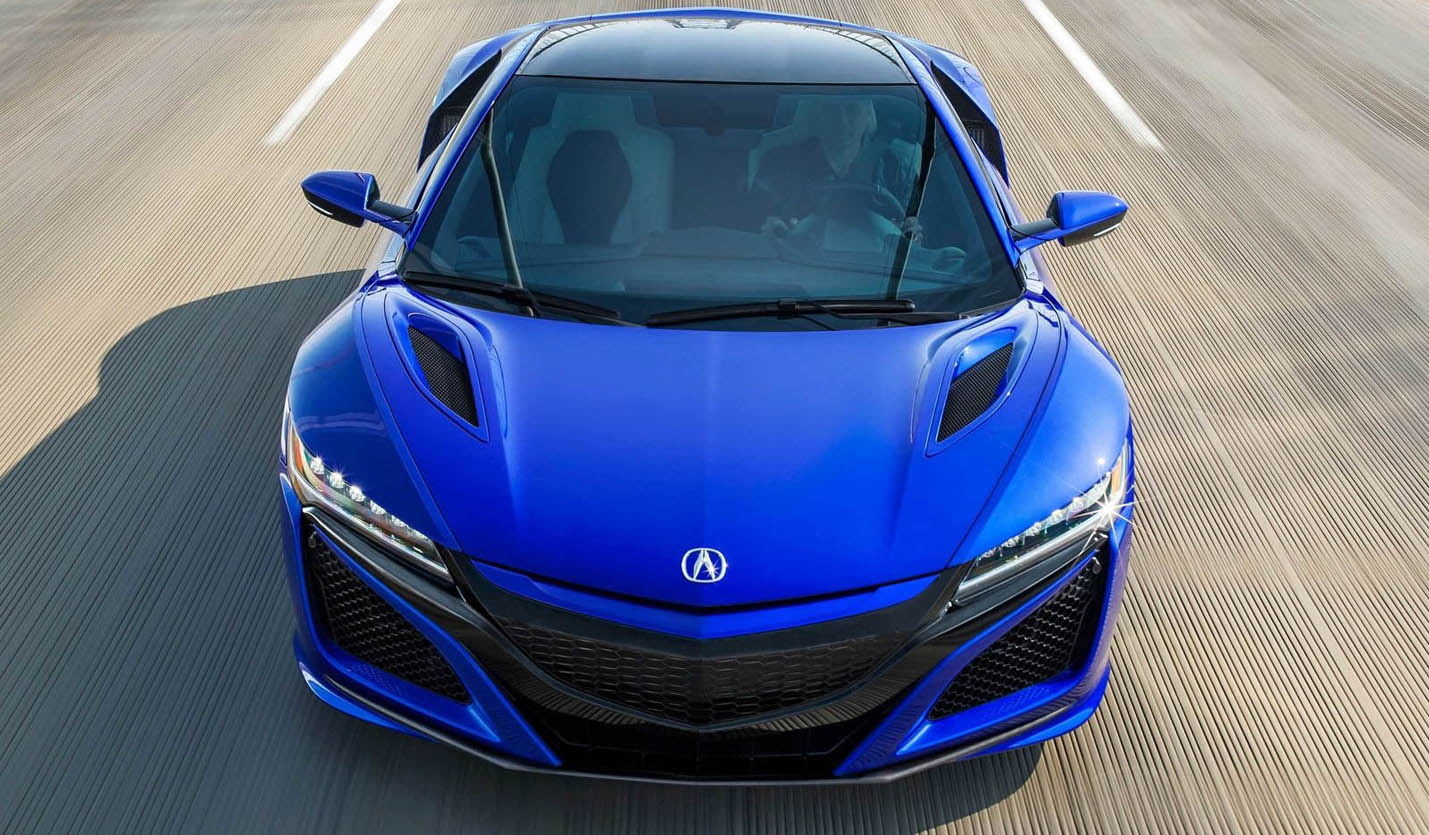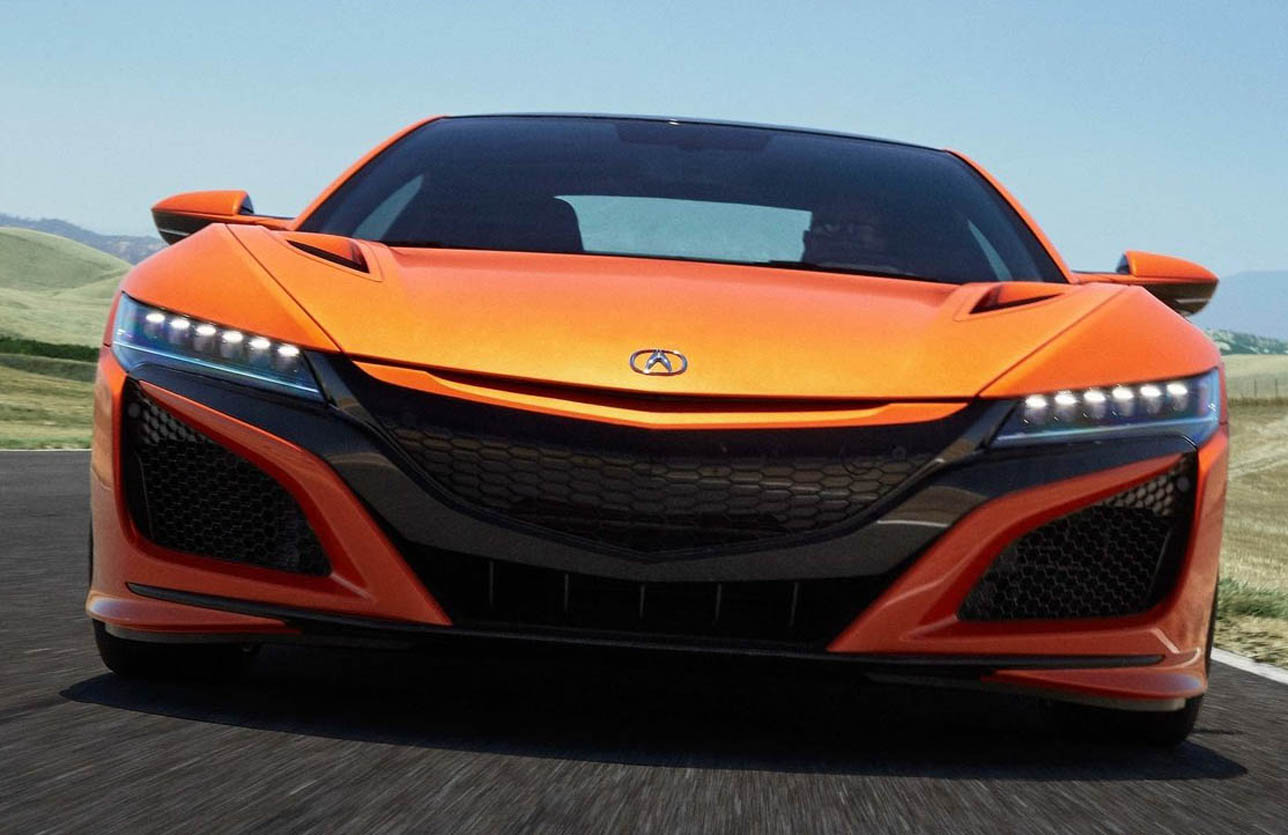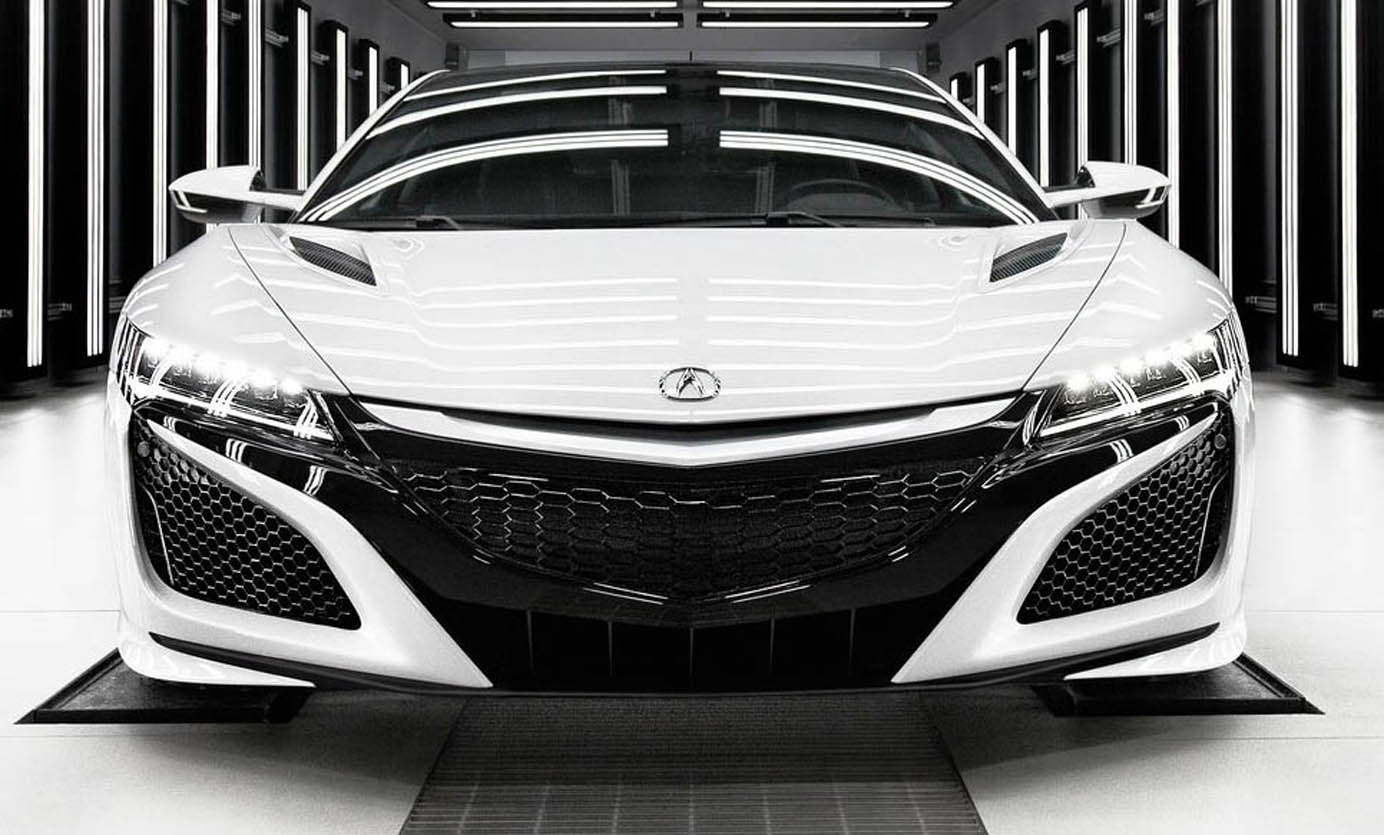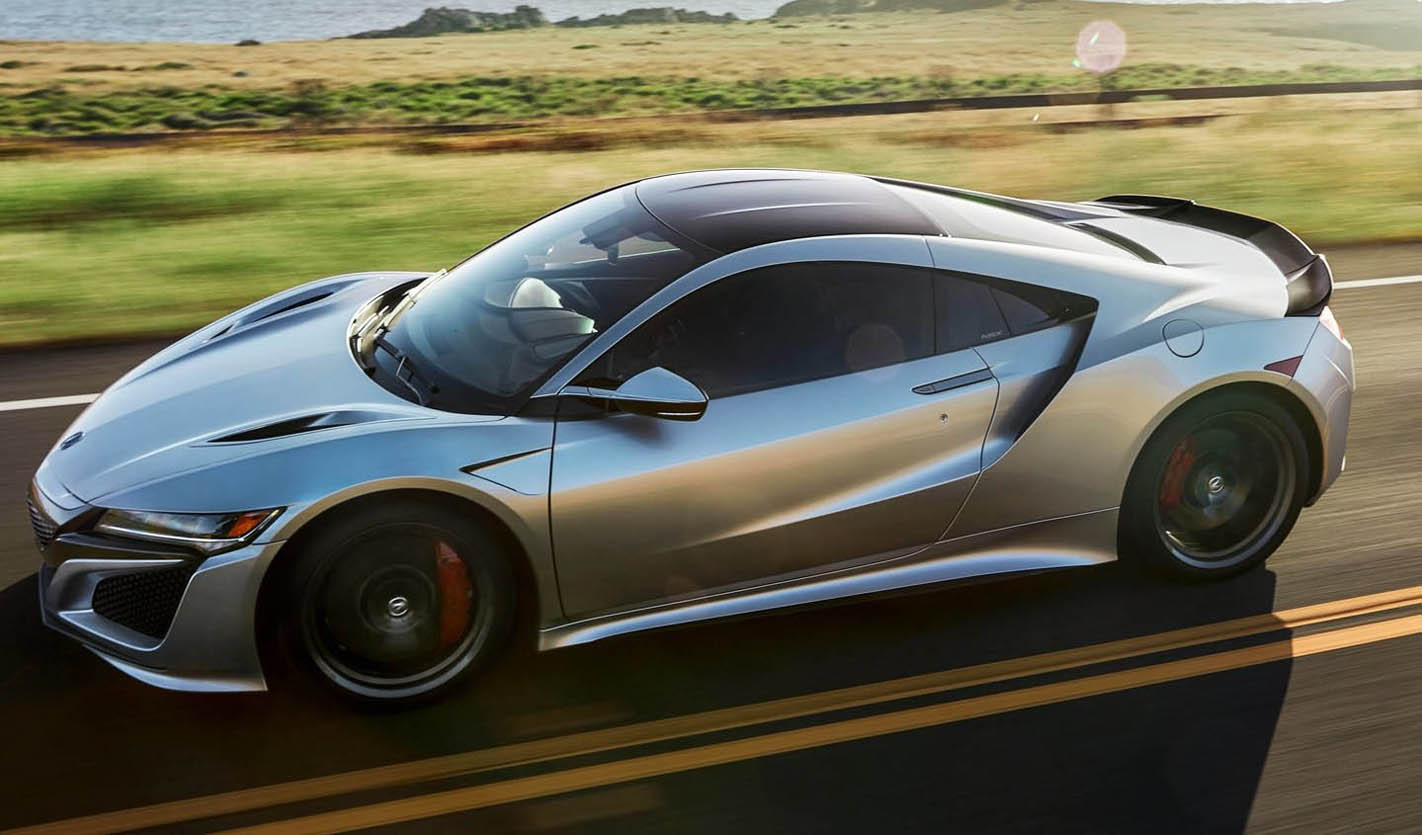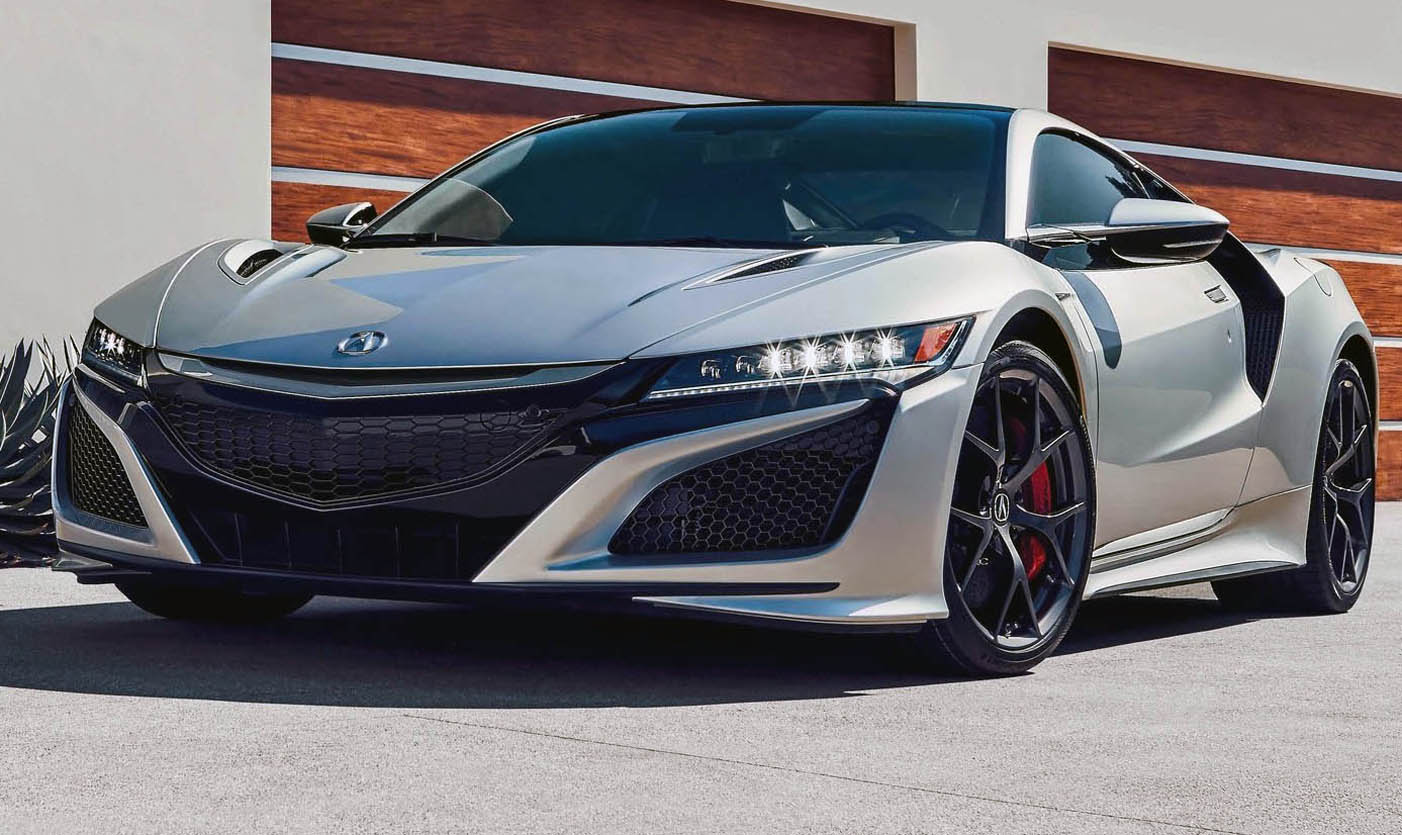
Specifically created to bring a ‘New Sports eXperience’ to the supercar segment, the Honda NSX challenges prevailing beliefs about supercars, just as the first generation NSX did so comprehensively over a quarter of a century ago.
When the original Honda NSX made its debut in 1989, it forever changed the supercar segment by offering dramatic supercar styling, performance and dynamics and breaking new ground in terms of quality, ergonomics and usability.
By making use of advanced new technologies, such as a lightweight yet rigid all-aluminium monocoque body and chassis, mated to a mid-mounted transverse V6 engine, the original NSX challenged conventional supercar wisdom. Its high-revving engine featured a number of innovative production technologies, including forged pistons, titanium connecting rods and VTEC valve train.
Moreover, the NSX sought a more intimate connection between driver, car and the road, pursued through essential design elements – low vehicle mass, high power-to-weight ratio, a rigid body supporting a performance-focused chassis, outstanding visibility, exceptional ergonomics and accessible performance. The result was a paradigm-challenging definition of a supercar.
Importantly, the first generation NSX also exemplified Honda’s high standards of quality, durability and day-to-day usability, without compromising performance – something rarely found in supercars of the day.
Respecting the core characteristics and differentiators of the original NSX, the new Honda NSX pursues an altogether new and revolutionary idea for Honda supercar performance, melding timeless sports car values with next-generation technologies to create a New Sports eXperience. Just as Honda’s precision crafted performance DNA guided the creation of the original NSX, every aspect of this new design is accordingly a next-generation expression of those same values.
As a twenty-first century ‘human-centred supercar’ and the ultimate representation of Honda performance and prestige, the all-new NSX is the product of nearly four years of intensive effort by a global design and engineering team. Based on the man-machine synergy approach that guides the development of all Honda vehicles, the company created a driver-centred supercar in which every part of the vehicle is respectful of the smartest part of the car – the driver.
Foremost among its many innovations is Sport Hybrid Super Handling All-Wheel-Drive (Sport Hybrid SH-AWD), a first-of-its-kind technology in the supercar arena. By combining this new interpretation of Honda Super Handling performance with innovative approaches to vehicle design – including advanced body construction, component packaging and aerodynamic optimisation – the NSX faithfully translates the acceleration, steering and braking inputs of the driver with incredible fidelity and with instant response. It amplifies the capabilities of every driver, and greatly elevates the dynamic experience in every driving situation.
Through Sport Hybrid SH-AWD, the NSX is the world’s first supercar to utilise hybrid electric motors to enhance and elevate every element of its dynamic performance: acceleration, braking and cornering. With electrically powered torque vectoring provided by the front-mounted Twin Motor Unit, the NSX takes Honda Super Handling All-Wheel Drive technology to a new level – using the dynamic, instantaneous and continuous distribution of electric motor torque to enhance the precision of handling and cornering performance in all driving situations.
The revolutionary NSX Sport Hybrid SH-AWD power unit and its advanced dynamic capabilities are supported by new concepts in supercar design and body construction. The NSX’s multi-material spaceframe is a clean-sheet design, utilising a multitude of materials and joining technologies, each chosen for its unique capabilities to deliver unrivalled body rigidity in combination with low mass, outstanding visibility and class-leading occupant and crash protection. The NSX’s multi-material body integrates several world-first technologies, including three-dimensionally-bent ultra-high-strength steel A-pillars and ablation-cast aluminium frame nodes.
Likewise, the design and packaging of the Sport Hybrid power unit’s components – engine, transmission, motors, batteries and control systems – are optimised to support and enhance its dynamic capabilities by lowering the centre of gravity and centralising the mass within the car.
The new NSX is Honda’s flagship model and the ultimate expression – in series production form – of Honda’s vision for sporty and advanced vehicles. With first deliveries to European customers expected in autumn 2016, the NSX represents a critical step in re-establishing the Honda’s passion for performance enabled by advanced technologies.
Dynamic exterior design integrates supercar aesthetics with supercar performance
“The idea that form follows function is fundamental to Honda design. This philosophy is interwoven in the core of NSX, which is why our exterior concept is called ‘Interwoven Dynamic’,” said Michelle Christensen, exterior design project leader in the Los Angeles-based Honda Design Studio. “The NSX is a visual expression of beautiful design and performance working together, influencing every decision we made – every surface, every millimetre, every design element of the new NSX is focused on enhancing performance.”
The exterior design of the all-new NSX reflects the integration of supercar aesthetics and exceptional supercar performance. The ‘Interwoven Dynamic’ overarching design theme for the exterior architecture epitomises the concept of form following function, as every character line, body panel shape or crease, air flow inlet and outlet, and even the vehicle’s overall proportions have been designed to create a New Sports eXperience. Accordingly, each aspect of the NSX’s exterior architecture has been optimised to support the dynamic capabilities of the NSX while advancing Honda design into the future.
Every element of the NSX’s exterior serves a distinct purpose, one that has been carefully calculated through thousands of hours of complex computational fluid dynamics (CFD), in combination with extensive wind tunnel testing of 40 percent-scale and full-size models in the company’s advanced testing facilities in the United States and in Japan.
The acutely angled slope of the sculpted aluminium bonnet combines with the rakishly shaped LED headlights and tapered front grille to create an aggressive interpretation of Honda’s now-familiar family face. The distinctive multi-LED headlights are bisected by enlarged mesh-covered air inlets, while the front wings are accentuated by a sharply creased character line running all the way from the grille to the slender A-pillars.
Remarkably compact overhangs, front and rear, embody the exemplary packaging of mechanical and electrical components, while the sleek yet muscular overall stance conveys a sense of purpose and power. The bonnet line, roofline, floating C-pillars and rear quarter appear as one distinctive and unified curve. The large yet lightweight high-performance wheel and tyre package fits within the wheel arches with minimal gaps to highlight the taut proportions.
The rear of the vehicle is equally striking, emphasised by the signature floating C-pillars, which cascade gently from the roofline to forward of the integrated spoiler at the tailing edge of the rear deck, flanking an expansive glass panel that reveals the twin-turbocharged V6 engine.
Further accentuating the exterior architecture of the new NSX are a choice of eight paint schemes, each carefully selected to accentuate the exterior’s bold design while achieving the highest levels of paint quality within the supercar segment.
Total Airflow Management
To support the NSX’s ambitious performance targets, innovative packaging design and dramatic styling, Honda’s engineers completely reimagined the exterior engineering for this modern supercar so that maximum energy is extracted from the flow of air around and through the NSX with the highest efficiency.
This ‘total airflow management’ strategy supports complete power unit cooling and air intake, brake system cooling, and aerodynamic performance – drag and downforce – to an advanced level, offering unprecedented balance and confidence to enhance the driving experience.
There are seven different primary heat sources – the 3.5-litre V6 engine, two turbochargers, the nine-speed Dual Clutch Transmission (DCT), the Power Distribution Unit and the two motors within the Twin Motor Unit. To provide efficient cooling to each of these elements, airflow is managed through 10 different heat exchangers.
Openings at the front of the vehicle supply cooling airflow across the key heat exchangers located within the front section – front engine radiators, twin motor unit cooler, condenser, transmission gear cooler and hybrid Power Distribution Unit.
The airflow follows carefully optimised exit paths, which take into consideration total airflow, maximum downforce and a low coefficient of drag. The total airflow management approach results in a further consideration: exiting air is specifically manipulated to achieve a downstream flow pattern to feed the mid-engine air inlets.
Vents specifically positioned to reduce turbulence and aerodynamic loss around the front wheels work in conjunction with the hood and front fender vents to stabilise airflow down the side of the car to provide airflow to the signature side intakes, channelling it then to the engine intake, engine bay cooling, and turbo intercoolers. The side intakes are also designed to direct airflow over the rear deck to increase downforce.
Air flowing over the roof and down the rear hatch glass is captured to feed the transmission clutch cooler and facilitate engine bay cooling. A rear diffuser works together with the rear spoiler and taillight slots to generate significant downforce and effectively manage the drag created by the aerodynamic wake generated behind the car.
Total airflow management ensures the NSX’s exterior minimises aerodynamic drag while creating balanced front-to-rear downforce. An exhaustive research and development programme determined that placing approximately three times as much downforce at the rear relative to the front of the car would provide the optimal downforce balance for high-performance and day-to-day driving. The NSX’s high level of downforce is accomplished without the need for active aerodynamic bodywork or other devices.
Airflow management vents and precision ducting create strong, consistent downforce for the NSX and were tuned with aerodynamicist and designer input during wind tunnel test sessions. Six vortices flow at the rear, including those that support the highest downforce across the rear deck lid. Air flowing from below the car and exiting through carefully optimised rear diffuser fins is a critical vortex that further anchors the NSX to the ground. Uniquely, the fins are not parallel to each other, but are narrower toward the front of the car and wider at the rear. This design amplifies negative pressure, enhancing diffuser efficiency, which produces greater downforce.
The NSX aerothermal team evaluated the thermal loading in racetrack conditions, using both a chassis dynamometer and wind tunnel. In addition to simulating key performance parameters, such as engine speed and braking, the test included varying wind speeds based on real-world track data. Simulations included Sebring International Raceway and Virginia International Raceway, the latter serving as one of the primary development tracks for the new NSX.
Computational fluid dynamics (CFD) was used extensively during development to maximise the performance of all flow structures around the vehicle, to support hands-on experiments in wind tunnels during exterior design, and to optimise the thermal performance of the power unit. Firstly, for the proof-of-concept in establishing heat management strategy at the earliest development stage; and secondly, for continuous thermal performance improvement as the vehicle matured through development.
Along with the use of advanced CFD, wind tunnel and real-world testing, the development team also employed computerised lap-time simulation models of some of the world’s most legendary proving grounds that could then be run on chassis dynamometers, allowing testing and validation of computer models for thermal management.
NSX underwent extensive testing at the company’s state-of-the-art wind tunnel in Raymond, Ohio, using ultra-detailed 40-percent-scale models that replicate the suspension, wheels, tyres, intake and exhaust vents, heat exchangers and major under-bonnet components. The NSX was then verified and further refined through testing at full scale in the company’s wind tunnel in Tochigi, Japan and on real and simulated proving grounds throughout the world.
Floating C-pillars
The floating C-pillars integrated into the exterior architecture of the all-new NSX are as purposeful as they are distinctive, supporting efficient body-side airflow. The C-pillars extend outward from the sloping rear roofline so that, as air flows down the sides of the vehicle, it is efficiently rerouted into the side-mounted engine air intakes. The floating C-pillars also aid engine cooling by creating a negative pressure zone around the rear heat exhaust vents, along the outside edges of the rear windscreen, improving the efficiency of heat loss. The portion of air that flows down the side of the vehicle toward the outside section of the buttress is conditioned to reduce turbulence as it passes with minimal disruption over the rear wing and spoiler.
Door handles and boot access
The flush-fitting exterior door handles are both aesthetically pleasing and functional, extending outward from the door for use while at the same time supporting clean airflow along the body side when in motion.
The boot is accessed by means of the remote key fob, by a button located on the driver’s interior door panel, or by a button discretely located under the trailing edge of the boot lid. In the event of a loss of power, both the driver’s door and the boot also feature a traditional key cylinder for manual locking or unlocking of the doors and boot.
Supercar wash / wipe system
The wash / wipe system, engineered specifically for the new NSX, has been designed to operate effectively, even at maximum vehicle speeds. Tested in the wind tunnel at an airflow equivalent of over 290 km/h (180 mph), the spoiler-shaped wiper blades have been designed to generate downforce on the wiper blade, while the speed-controlled wiper motor maintains a constant wiping speed, ensuring highly effective wiper performance in all driving conditions. Likewise, the windscreen washer system utilises a three-nozzle system for superior coverage in all conditions and driving environments, including high-speed travel.
Further contributing to the enhancement of forward visibility and the provision of an unobstructed view of the road, the windscreen wiper arms are placed as low as possible at the base of the windscreen so that they remain completely out of the driver’s view when not in operation. Placing the wipers below the bonnet also helps reduce wind noise.
Door mirrors
Featuring a two-tone paint scheme that accentuates the NSX’s ground-hugging appearance and wide stance, the door mirrors include a thin blade arm to minimise air turbulence as air flows along the side of the vehicle. This reduces local airflow noise, prevents disruption of air flowing to the side intakes, and minimises aerodynamic drag. In keeping with the ultra-high-strength A-pillars, the thin blade arm design improves visibility when parking and cornering. Each mirror housing includes an LED indicator.
LED Lighting
The exterior design of the all-new NSX includes a variety of light-emitting diode (LED) lighting features, including LED headlights, LED daytime running lights, and LED tail lights. Designed to complement the exterior’s low and wide stance, each headlight assembly contains six individual LEDs, with four in operation when using the low beam setting (utilising the four outer LEDs) and employing all six LEDs when the high beams are activated.
The headlight LEDs provide superior down-the-road illumination with outstanding light distribution and light characteristics with a wavelength close to the human eye’s luminosity curve. With their streamlined shape and lower electrical power consumption, the NSX’s LED headlights also aid fuel efficiency and have a longer operational life compared to traditional halogen or high-intensity discharge (HID) lamps.
Occupying the top half of each LED headlamp that makes up the headlight assembly are the NSX’s LED daytime running lights. Located just beneath the LED headlamps are the LED position lights, composed of a series of small and tightly packed LEDs that run in a thin continuous line along the bottom of the headlight assembly. LED lighting is also used for the turn signals at both the front and rear of the vehicle.
This integrated LED-based lighting system creates a design aesthetic that complements the smooth, flowing and streamlined character lines of the vehicle, rather than calling individual attention to the daytime running lights themselves. Most importantly, the design featured on the new NSX provides vivid illumination that can be easily seen by pedestrians or other vehicles during daytime hours.
Similar in character to the headlights at the front of the vehicle, the LED tail lights have a compact and narrow appearance with a uniquely freeform shape. The LED tail light array starts off wider, toward the centre portion of the rear of the vehicle, then gently tapers as it wraps around towards the outside corners and rear wheel arches.
Exterior finish
The highest levels of paint quality with reduced environmental impact were targeted at Honda’s innovative new Performance Manufacturing Centre (PMC), consistent with the ethos of ‘next-generation quality and craftsmanship’.
The NSX’s exterior body panels are not attached to the spaceframe until the conclusion of the vehicle assembly process. As a result, body panels are treated and painted separately from the frame and are finished to an exceptional level of quality and lustre by expert technicians at the PMC.
NSX body panels enter the paint process attached to a specially designed fixture that locates the panels in a position and angle similar to how they are oriented once installed on the vehicle. All body panels are covered with a high-quality primer coat and, depending upon the specific colour application, then receive between five and seven coats of paint. Each layer of coloured paint applied to the body panels is allowed to fully cure prior to the next application. A high-quality and durable clear coat is then applied.
To help minimise the potential for ‘orange peel’, which occurs when the clear coat on vertical body panels is pulled down by gravity during the curing process, the body paint fixture has hinges that allow the vertically oriented body panels – doors and wings – to be rotated to a near-fully horizontal position during the curing process. Once cured, the panels undergo careful inspection in a newly designed inspection booth utilising high-intensity LED lighting to help the craftspeople identify and address even the smallest irregularities. Body panels are then hand finished after the first layer of clear coat, and again after the second clear coat.
The most intuitive and advanced sports hybrid power unit in the supercar segment
The exceptional dynamic capabilities of the new NSX are enabled by its revolutionary Sport Hybrid Super Handling All-Wheel Drive (SH-AWD) power unit, the first such system of its kind in a supercar to utilise electric motor torque in combination with engine power, to enhance every element of dynamic performance – acceleration, handling and braking.
At the heart of the new Sport Hybrid power unit is a bespoke, mid-mounted twin-turbocharged V6 engine, paired with an all-new nine-speed dual clutch transmission (9DCT) and Direct Drive Motor that supplements the engine with instant torque response. Together, these components comprise the rear power unit. Amplifying the instant responses and dynamic handling performance of the NSX is the front Twin Motor Unit (TMU), with two electric motors independently driving the left and right front wheels.
The NSX’s Sport Hybrid power unit offers exceptional horsepower and torque with a broad powerband for tremendous throttle response and acceleration. Total system peak output is 581 PS: 507 PS from the gasoline engine and 74 PS from the front TMU and Direct Drive Motor.
By creating a propulsion system that makes use of both mechanical and hybrid-electric components rather than just a conventional gasoline-powered internal combustion engine, the NSX’s power unit is able to create constant and linear acceleration at any point in the power band, at any speed with instant response.
At initial launch from a standstill, the front-mounted Twin Motor Unit (TMU) and the direct drive electric motor are able to immediately supplement power production from the twin-turbocharged V6 engine, using the abundant and instantaneous torque production that is an inherent characteristic of electric motors. Conversely, once the vehicle has reached a steady cruising speed, the twin-turbocharged V6 engine becomes the primary motive force for the vehicle, with the three electric motors providing supplementary power and yaw control when necessary.
While the primary focus in the development of the all-new NSX’s clean-sheet power unit was peak performance, efficiency and environmental sustainability were also important design characteristics. Therefore, the all-new NSX meets ultra-low emissions vehicle (ULEV) requirements.
Twin-turbocharged V6 engine
Featuring a wide V-angle of 75 degrees for a low centre of gravity, the NSX’s twin-turbocharged V6 engine achieves an ideal balance between power production, compactness and reduced mass. With a displacement of 3.5 litres, it combines both direct and port fuel injection, along with Dual Variable Valve Timing Control (Dual VTC) to deliver optimal camshaft phasing. Dual VTC allows for precision combustion control at all engine speeds while simultaneously achieving high power output and uncompromised performance at high engine speeds.
Other key engine design elements include a sand-cast engine block, lightweight and compact cylinder heads, and plasma transferred wire arc thermal spray-coated cylinder walls (for higher thermal efficiency with reduced weight and compactness). A dry sump lubrication system significantly reduces the engine’s centre of gravity while simultaneously ensuring consistent engine lubrication under high cornering load conditions.
The NSX has a compact valve train utilising swing arm-type valve actuators, which allows for a more compact head structure and reduces by 22 percent the inertial weight of the valve train compared to a rocker arm-type design. The innovative design was derived from Honda racing engines. Intake and exhaust variable camshaft timing (VTC) is deployed to provide an excellent balance of high power, torque, fuel efficiency, and emissions.
The engine also features for the first time on a Honda a three-piece water jacket for the engine block and heads, including water jackets between the cylinder bores, a triple radiator system and a viscous damper mounted to the crankshaft.
Turbocharging system
Developing a bespoke twin-turbo system for the all-new engine was a logical choice, offering a strong balance of high power with considerable torque, high fuel efficiency and low emissions, while also offering inherent packaging advantages.
Through careful research, testing and development, Honda’s engineers were able to determine the ideal boost pressure for efficient and suitable power while simultaneously meeting Honda’s stringent benchmarks for reliability and longevity. Maximum boost pressure is set at 105 kPa (1.05 bar / 15.23 psi).
Increasing the engine intake air pressure increases intake air temperature, which, if not controlled properly, increases the risk of pre-detonation. To counter this increase, a high volumetric flow air-to-air intercooler is adopted, dramatically reducing intake air temperature while simultaneously increasing the density of the air intake charge for maximum power production.
Making use of an electronic wastegate for each turbocharger for fast response and precise control, the single-scroll turbocharger design allows for the use of smaller turbos to reduce weight and improve packaging while still meeting power and performance benchmarks.
Plasma transferred wire arc thermal spray coating
Utilising an aluminium engine block and heads presents three key advantages compared to traditional cast iron block and head configurations: greatly reduced mass, improved thermal conductivity, and improved heat dissipation. Most aluminium engines require the fitment of cast iron cylinder liners to provide sufficient wear resistance. Honda’s engineers addressed this issue by employing a plasma transferred wire arc thermal spray to the cylinder walls – a recently developed technique that offers an increase in heat transfer (thermal conductivity) of 52 percent with greatly reduced weight compared to cast iron liners.
The plasma transferred wire arc thermal spray process melts a thin-diameter wire down to an atomised form that can then be sprayed onto the cylinder walls. A supersonic plasma jet formed by a transferred arc between the tip of the wire and a cathode is used to spray the molten material, stacking the tiny particles on top of each other to form a very thin yet extremely wear-resistant coating.
Along with improved engine efficiency via reduction of internal friction, additional benefits from the plasma transferred wire arc thermal spray process include an approximately 3 kg decrease in overall engine weight when compared to iron cylinder liners, improved wear resistance, reduced oil consumption, increased horsepower and torque production, and enhanced throttle response.
Furthermore, thanks to the addition of plasma transferred wire arc thermal spray, additional water channels are able to be placed between the cylinder bores for improved cooling efficiency via better control of coolant flow.
Cylinder heads
Drawing on Honda’s extensive racing experience, the cylinder heads fitted to the twin-turbocharged V6 are highly compact and include smaller valve train components. This has resulted in a notable reduction of inertial weight as well as a 22 percent reduction in cylinder head mass when compared to conventional designs. This reduction in mass also helps lower the vehicle’s centre of gravity.
The cylinder heads utilise a three-piece water jacket for improved cooling efficiency along with improved coolant flow control. Additionally, the race-inspired cylinder head design optimises the swirling of intake air so that fuel mixes with it in a more ideal manner for improved combustion, improving efficiency and emissions performance.
High specific power output
With a compression ratio of 10.0:1, the NSX’s engine has a specific power output of more than 140 PS per litre of engine displacement. The engine safely and reliably achieves this high specific power output through a number of advanced engine technologies, including the efficient twin-turbo system, reduced friction and heat transfer properties of the plasma transferred wire arc thermal spray on the cylinder walls, sodium-filled exhaust valves, implementation of both direct and port injection, and the superior combustibility of fuel from the high tumble ports.
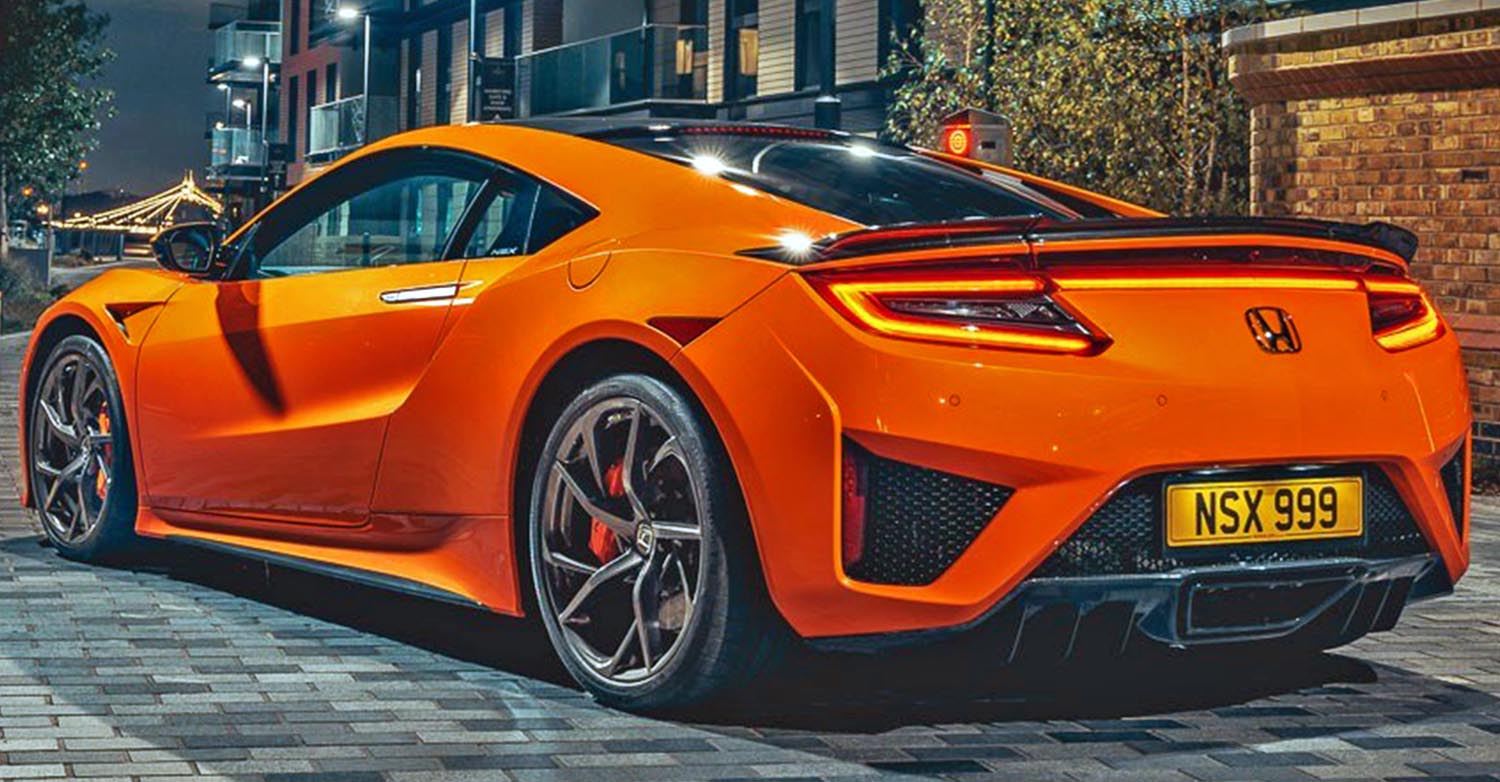
Dual Variable Valve Timing Control (Dual VTC)
The NSX engine incorporates proprietary Dual Variable Valve Timing Control (Dual VTC) variable valve timing control technology, which delivers an excellent balance of high torque and maximum power output with reduced exhaust emissions and superior fuel efficiency.
At engine idle, Dual VTC stabilises combustion for smooth idling by minimising intake and exhaust valve overlap and, therefore, decreasing the amount of exhaust gas recirculation. During constant-speed driving or under light acceleration, the system reduces exhaust emissions and engine pumping losses by optimising valve overlap. Under wide open throttle at low engine speeds, the overlap of the intake and exhaust cam timing is expanded so that the turbochargers can work at maximum efficiency for optimal power delivery and responsiveness. Conversely, when operating the engine at high engine speeds, overlap of the exhaust and intake timing is minimised for improved volumetric efficiency to create maximum power.
Direct and port fuel injection
The NSX engine combines both direct and port fuel injection systems to provide for outstanding power production while simultaneously offering exceptional emissions performance.
Direct injection is the primary means of fuel delivery within each cylinder, while port injection is used for additional power output in high-performance driving situations. The direct injection system’s electric fuel injectors are mounted in the cylinder head and spray a very fine, highly atomised mist of fuel directly into each cylinder under very high pressure so that the fuel ignites almost instantaneously and completely, maximising engine performance and fuel efficiency with reduced emissions. Under high performance demands, the port injection system supplements the direct injection system, feeding fuel into the intake ports where it mixes with the incoming air for increased power production.
The direct and port injection systems for the engine are fed by two specially designed fuel pumps, one feeding the direct injection system at a fuel pressure rate of 4.48 bar (65 psi), the other supplying the port injection system at a pressure of 3.52 to 5.03 bar (51 to 73 psi).
By optimising the direct injection system – precise control of fuel spray pattern, particle shape and size, and timing of fuel flow – with the operation of the engine’s twin turbochargers, Honda’s engineers were able to improve combustion efficiency and power output, also assisted by the high tumble intake port design. The approach ensures the necessary amount of fuel for maximum power output is always supplied from both the direct and port injection systems while optimising the combustion process of the direct injection and high tumble airflow within each cylinder for outstanding emissions performance. The production of hydrocarbons and particulates is reduced by avoiding fuel wetting on the piston and cylinder sleeve.
An advanced lean-burn combustion technology allows for homogenous and weak stratified combustion to occur within the cylinder, through ultra-precise control of the fuel injection. By ensuring that fuel spray angle and direction do not interfere with the intake valves, along with a strong air / fuel swirl from the high tumble port, high power output and low emissions are effectively combined. Along with optimised shaping of the piston head and intake port shape, the highly accurate and measured fuel spray and injection pattern play a pivotal role in this advanced combustion concept.
A two-into-one inlet manifold design minimises torque deviation between each bank of cylinders. Twin throttle bodies allow more air into the system and finer throttle control while simultaneously reducing the pulsation of air.
Exhaust system
Compact and lightweight, the stainless steel exhaust system includes two catalytic converters per cylinder bank and four outlets for excellent exhaust gas flow and low emissions. Silicon exhaust system mounts resist heat and firmly secure the exhaust system to the vehicle, helping to reduce vibration while ensuring system integrity and long life.
An Active Exhaust Valve (AEV) system has been developed that matches the exhaust note to the dynamic driving situation, operating as a complementary component of the Integrated Dynamics System. The system utilises two distinct exhaust paths controlled by two electrically-operated valves.
In Quiet mode, the exhaust valves are closed and the exhaust gases pass through silencers for a more subdued sound. In Sport mode, the exhaust valves are closed unless driver demand is high enough, at which point they open. In Sport+ or Track modes, the AEV system is open, bypassing the silencers for a full, uninhibited flow of exhaust gases and a voluminous and full-throated exhaust note.
Dry sump lubrication
In another application of race-bred technology, the all-new NSX is the first production Honda vehicle to use a dry sump engine lubrication system. By replacing the engine’s conventional oil pan with a separate oil reservoir and a dedicated chain-driven oil pump mounted directly to the lower engine block, the system is designed to prevent oil starvation under high lateral G loads.
After being fed to the engine for lubrication, oil is collected from the lower engine block by six separate scavenger pump impellers and then fed back into the oil tank by a pair of pump rotors.
Importantly, the adoption of a dry sump lubrication system allowed designers to mount the engine 61 mm lower within the chassis, thanks to the elimination of a traditional oil pan. The more efficiently cooled oil also helps promote maximum engine power output.
‘Starter-less’ engine start system with idle stop
As a byproduct of its Sport Hybrid power unit, the NSX utilises its Direct Drive Motor to start the engine in place of a conventional 12-volt engine starter motor.
Along with a significant weight savings, further mass reduction was realised by eliminating the 12-volt starter ring gear normally required by a conventional engine starting system.
To improve fuel efficiency further, the NSX is equipped with idle stop capability. When the system is active and certain operating conditions are met, the engine will automatically shut off when the vehicle comes to a stop. The system is not engaged when Sport+ or Track modes are selected. When stopped, a special cold storage evaporator in the air conditioning system helps maintain a comfortable cabin temperature even in warm weather.
Engine restarts are exceptionally smooth and quick, supported by the use of the powerful Direct Drive Motor as an engine starter. Idle stop operation is also fully integrated into the operation of the Automatic Brake Hold system.
Engine balancing and running in
Honda’s engineers further improved engine performance and refinement through reduction in experienced noise, vibration and harshness (NVH). The latest in engine balancing technology and a number of new processes are applied to achieve optimal balance. These include the use of next-generation engine diagnostic equipment to more accurately measure engine imbalance, and the application of variable bolt weights that are applied to the eight mounting holes on the flywheel and the addition of nine mounting holes in the crankshaft viscous damper, which can be used for fine-tuning. Achieving a high degree of harmonic equilibrium not only greatly reduces engine vibration, but also decreases wear of the engine’s internal componentry for superior reliability and longevity.
The flywheel also acts as a mass damper. The inclusion of an integrated mass damper, or flywheel, is one of the most lightweight components that could be added to minimise mechanical and harmonic vibration caused by oscillation, thereby greatly reducing NVH while helping to ensure structural integrity and longevity of the transmission case.
As an important additional quality step prior to fitment within the NSX, the engine undergoes a running in programme. The engine is placed under load on a specially designed engine dynamometer that simulates the equivalent of 150 miles of service.
Nine-speed Dual Clutch Transmission with Direct Drive Motor
The NSX features a bespoke nine-speed dual clutch transmission (9DCT) which works in concert with the Direct Drive Motor to make full use of the power unit’s broad powerband, producing quick and precise gear changes that support the instant acceleration responses. As a key component of the power unit’s packaging, the 9DCT has been optimised for compact size, low mass and low centre of gravity.
The 9DCT has a very wide ratio range that allows for optimal gear selection via the competition-inspired, steering wheel-mounted paddle shifters in any driving condition. First gear ratio is configured for maximum vehicle launch acceleration, while the close-ratio gears (second to eighth) are matched to make the most of the power unit’s powerband. Conversely, top gear (ninth) has been optimised for fuel efficiency during constant high speed cruising. When driving in ninth gear on a level surface at 97 km/h (60 mph), the twin-turbocharged 3.5-litre V6 engine is spinning at only 1,700 rpm.
In order to achieve compact dimensions, the clutches and the differential are uniquely situated side-by-side in a common housing. The parallel shaft layout reduces overhang from the rear axle while the centre of mass is moved forward, which in turn reduces the length of transaxle assembly.
The 9DCT incorporates several advanced features. An electronically-operated wet dual clutch, high-rigidity shift fork, double-cone synchronisers for second to fifth gears, and an electronic shift actuator combine to synchronise shift timing precisely with power unit torque for the quickest and smoothest gear shifts possible. A precision surfaced high-efficiency hypoid bevel gear tooth shape for all gears ensures smooth operation and minimal gear noise. Two oil chambers within the transmission housing provide efficient and high-capacity cooling, while the inclusion of exclusive new gear oil ensures higher viscosity and improved lubrication throughout the gear train (when compared to a conventional heavier gear oil that increases viscous drag).
Customisable quick response gear shift system
One of the key evaluation parameters for Honda’s engineers was the speed with which the NSX could change gear. To deliver superior gear shifting performance, the 9DCT features unique components within the gearbox to accomplish smooth yet almost instantaneous gear changes.
Highly rigid shift forks composed of a specialised, high-strength cast iron play a key role in providing a smooth yet quick shift response. The shift forks straddle the gear shaft with a ‘U’-shaped portion that engages with the selected gear, pushing it forward and engaging the gear within the gearbox. The 9DCT uses a total of five shift forks for the gear actuator system: a one-way clutch is used for first gear; four shift forks are used for second to ninth gears; and a fifth shift fork is employed for Park and Reverse.
Ultra-quick gear shift response and engagement with reduced weight is aided by the use of a compact electric motor as a gear actuator – as opposed to a conventional pneumatic or hydraulically operated gear actuator. This system reduces weight by eliminating the high-pressure hydraulic pump that is typically used in a gear actuator system, while providing for excellent reliability and system robustness when compared to other available gear actuation systems.
Similarly, an electrically operated clutch actuator eliminates the need for a high-pressure hydraulic pump. Control of the clutch is accomplished via a closed-circuit hydrostatic structure, which allows for the generation of oil pressure on demand as needed with greater efficiency.
The performance and shifting characteristics of the 9DCT can be through the transmission operation settings within the driving modes of the Integrated Dynamics System. In Quiet mode the transmission shift map promotes gear shifts at lower engine speeds. Sport mode allows the engine to rev more freely and makes gear changes at higher engine speeds. Sport+ mode accommodates higher engine speed gear changes with quicker, more aggressively executed upshifts and downshifts, while Track mode offers the fastest upshift speeds – 40 milliseconds faster than Sport+.
Limited-slip differential
The NSX’s responsive handling is enhanced by a mechanically-based limited-slip differential (LSD). Designed to deliver excellent poise and stability while maximising the performance of the power unit, the torque-sensitive multi-plate clutch is lighter and more compact than a similar unit with a helical gear configuration. Furthermore, the multi-plate design allows for improved wheel coupling for smoother and more efficient operation.
The torque bias ratio – an index for slip limit torque that compares torque shifted from a high rotation axle to a low rotation axle – has been optimised to provide two distinct LSD performance settings ideal for when the wheels are being driven or when the vehicle is coasting.
Engineered to complement the Twin Motor Unit (TMU) and Vehicle Stability Assist (VSA) systems with precision torque vectoring and enhanced traction maintenance, the LSD enhances vehicle performance in a number of driving situations. Under braking or when decelerating approaching a turn, the LSD increases engine braking torque on the outside wheel for improved vehicle stability. During straight-line driving, torque is transferred left-to-right as necessary for enhanced vehicle stability. Under acceleration or while turning, overall traction and poise is improved by shifting torque to the outside wheel as traction from the inside wheel decreases.
Rear power unit mounting
By employing widely spaced power unit mounting brackets – up high at the front of the engine along with a mounting cradle bracket down low at the rear (connected to the 9DCT) – the position of the rear power unit (engine, Direct Drive Motor and 9DCT) is optimised to significantly reduce roll, pitch and yaw motion, providing greater acceleration and handling response.
Sport Hybrid systems
The Sport Hybrid system is a suite of highly advanced components at the centre of the hybrid-based systems of the power unit. Each of its components is engineered to minimise both weight and size in order to reduce overall vehicle mass, and carefully packaged within the NSX to lower and centre the mass of the vehicle. Collectively, the Sport Hybrid system includes the Twin Motor Unit (TMU), Direct Drive Motor, Power Drive Unit (PDU), and Intelligent Power Unit (IPU).
Twin Motor Unit (TMU)
The new NSX’s instant and linear acceleration coupled with outstanding dynamic capability is enabled in part by its front-mounted Twin Motor Unit (TMU). Designed to be as small and lightweight as possible while delivering ample torque and power, as well as precise torque vectoring to the front wheels, the TMU is a unique and highly efficient solution. The TMU provides supplemental power in conjunction with the twin-turbocharged V6 engine for instantaneous acceleration and provides true torque vectoring at any vehicle speed to enhance the NSX’s dynamic excellence.
In addition to instant torque, the TMU offers all-wheel drive (AWD) capability, allowing direct and immediate acceleration with a heightened sense of the associated G forces. Further, the TMU can dynamically apportion its torque to create a yaw moment, enhancing cornering performance. The TMU recovers braking energy during deceleration to supply power to the hybrid batteries.
Inside a die-cast aluminium housing, two 37 PS electric motors are positioned back-to-back. Each motor powers a single front wheel and can also apply negative torque to the same wheel. A gear mechanism allows the motors to decouple and still provide on-demand torque vectoring, helping to improve efficiency in certain conditions. To achieve these functions, the TMU uses a double pinion planetary deceleration mechanism, a separation mechanism and an oil pressure control system.
In order to achieve maximum acceleration from a standstill, and to meet Honda’s target of instant response, the TMU and Direct Drive Motor provide the initial accelerative force during acceleration from a standstill. After the first 0.15 seconds and 0.1 G from initial acceleration, the high horsepower and torque from the twin-turbocharged V6 engine becomes the primary acceleration force, supported by power from the Direct Drive Motor.
The TMU is also a key motive force for driving in the Quiet mode setting of the Integrated Dynamics System (IDS), allowing for hushed vehicle operation by powering the NSX electrically for short distances.
Direct Drive Motor
The Direct Drive Motor, packaged between the twin-turbocharged V6 engine and the 9DCT, is an ideal packaging solution of an electric traction motor to provide additional torque and power assist to the rear wheels.
In order to help eliminate the response delay typically associated with turbocharged engines, the Direct Drive Motor acts directly on the engine’s crankshaft which, together with the TMU, supports the NSX in achieving immediate, high-output, high-torque acceleration performance. The effectiveness of this design is particularly noticeable in everyday driving when accelerating from rest and at low engine speeds. Additionally, the Direct Drive Motor operates as a generator to help charge the hybrid batteries, while also acting as the engine starter.
The Direct Drive Motor features a liquid cooling passage that provides ample cooling and heat dissipation even when the system is being worked hard, such as during circuit driving.
Intelligent Power Unit
Neatly packaged in the cabin, just in front of the rear firewall, the Intelligent Power Unit (IPU) acts as the primary hub of the E-Drive system. The IPU integrates the lithium-ion battery pack, junction board, a high-voltage distribution bus bar, 12V DC/DC converter, electric motor/ECU, lithium-ion battery ECU and the ECU for the TMU.
As a result of integrating a next-generation lithium-ion battery pack and a caseless structure for key IPU components, the NSX’s IPU system is 35 percent smaller and 30 percent lighter than a similar IPU.
When driving in Sport, Sport+ and Track modes, the NSX’s air conditioning system is used for supplemental cooling of the IPU for optimal efficiency and performance. During development, the system was tested extensively in the desert heat of Dubai in order to ensure its proper function in extreme ambient temperatures.
Lithium-ion battery pack
Packaged within the IPU is the lithium-ion battery pack which stores the electrical energy to power the TMU and Direct Drive Motor.
The high-output lithium-ion battery pack consists of four modules, each with 18 individual battery cells (72 cells in total) contained within a specially designed caseless structure that utilises the vehicle body itself for a lightweight yet sturdy housing.
Incorporating the latest advancements in lithium-ion battery technology for automotive applications, both the positive and negative electrodes have been optimised for increased energy and efficiency. The battery pack is also the lightest and smallest to be engineered into any Honda vehicle. When compared to other Honda hybrid units, the NSX battery pack’s power density (stored energy per kilogram) has been increased by 10 percent, while energy density has been raised by 15 percent.
Power output and efficiency of battery operation have been further improved by implementing a co-operative cooling system, fed by fresh cool air channelled into the passenger compartment via the air conditioning system. Cool air from within the cabin circulates through ducting to cool both the lithium-ion batteries as well as the DC/DC converter.
Power Drive Unit
The Power Drive Unit (PDU) dictates the power management strategy of the Sport Hybrid SH-AWD system, including motor power and battery recharge. The PDU also incorporates three separate converters (converting direct current to alternating current) for use by the power unit’s three electric motors: the twin motors of the front-mounted TMU and the Direct Drive Motor. This compact ‘three-into-one’ PDU design is critical to the system’s compact packaging and the ability to mount it centrally in the vehicle, in the centre tunnel beneath the centre console.
Innovative new multi-material body with world-first material applications and construction processes allows lighter weight with increased strength
Honda’s engineers took a bold and challenging new direction to unlock the full potential of the NSX’s Sport Hybrid SH-AWD powertrain and fulfil the high targets set for its total dynamic performance. The resulting clean-sheet, multi-material approach breaks new ground in the automotive realm – with new materials, new construction methods and new thinking in supercar body design.
By starting from scratch, Honda’s engineers were able to choose the optimal material application and construction methodology for each area of the body, targeting both low mass and ultimate rigidity while also satisfying other critical design objectives. Accordingly, superior outward visibility, class-leading crash safety performance and world-class quality and durability befitting a next-generation Honda supercar were all accomplished.
The multi-material body, with its aluminium intensive spaceframe, is designed to achieve structural rigidity far superior to its best-in-class competitors. This high level of dynamic rigidity provides a crucial foundation for the NSX’s instantaneous responses. Accordingly, drivers will feel their inputs directly translated to the car’s actions with incredible speed and fidelity, while simultaneously allowing the maximum potential of the Sport Hybrid SH-AWD system to be realised – the essence of the New Sports eXperience.
“The challenge for Honda’s engineers was to create a body with a high level of rigidity to be able to transmit the full feeling of this powertrain directly to the driver without delay,” said Shawn Tarr, chief engineer for the NSX body development. “While the all aluminium unibody of the original NSX was ahead of its time, we would need to look to world-first technology in order to achieve this new level of rigidity.”
The body construction – performed entirely at Honda’s Performance Manufacturing Centre (PMC) using domestic US and globally sourced parts – is undertaken with innovative new techniques and technologies, and with a commitment to quality unmatched in the supercar realm. MIG welding of the aluminium-intensive spaceframe, for example, is performed entirely by high-precision robots, with all welds and body components undergoing a detailed inspection by highly skilled PMC weld technicians. Building the spaceframe to such a high quality and accuracy eliminates the post-construction machining activity that is common in low-volume vehicle manufacturing. This commitment to next-generation quality through the optimum blend of machine precision and human craftsmanship is apparent in every aspect of the body construction, finishing, painting and assembly, and is clearly identifiable in the final product.
Multi-material body and spaceframe
The multi-material body, with its aluminium-intensive spaceframe, offered Honda’s engineers the best structural rigidity and lowest platform weight with superior packaging for the power unit. NVH is also greatly minimised by the NSX’s global rigidity benchmarks – two times static and three times the dynamic level of torsional rigidity demonstrated by the next highest competing vehicle evaluated by Honda’s engineers.
Highly rigid and reinforced extruded aluminium beams comprise the majority of the spaceframe and are utilised for the front and rear frame rails and cross members, front and rear bulkhead frame members, floor cross members and side rails. A number of these aluminium extrusions are filled with acoustic spray foam to further aid noise attenuation, which is used in 38 different locations.
Cast aluminium nodes serve as joining points for the extruded aluminium frame members, as well as ultra-rigid mounting points for the front and rear suspension systems and the rear Sport Hybrid Power Unit. These nodes are either gravity die cast or – in front and rear crush zones – formed using advanced new ablation casting technology, a world’s first automotive application.
In another world’s first, the upper portion of the A-pillars and roof rails, which comprise one continuous section, are formed using three-dimensionally bent and quenched ultra-high strength steel tubing. This new metal forming process allows enhanced styling and outward visibility while providing high roof-crush strength.
Aluminium stampings are utilised as lightweight closure panels for the rear floor, rear bulkhead and B-pillars. The front floor panels are constructed from carbon fibre for strength and low weight.
Ablation cast nodes
One of the most difficult design challenges was minimising the front and rear overhangs while managing collision energy absorption in key areas, for crash safety performance and maintaining optimal structural rigidity. Honda’s engineers developed an innovative new technology called ablation casting – an all-new material application and a world’s first application in the automobile industry – to solve these complex and competing design imperatives. Ablation casting was matured from a fundamental research theme to production vehicle application within the development cycle of the new NSX – a major design, engineering and manufacturing achievement.
Jointly developed with specialist company Alotech, ablation casting is utilised in the creation of six joining members, or nodes – two upper and two lower nodes in the front frame, and two nodes in the rear frame. These nodes also serve as ultra-rigid mounting points for both the front and rear suspensions and for the Rear Power Unit. The front upper nodes are designed to absorb and dissipate energy in a frontal collision. The two ablation cast nodes in the spaceframe at the rear of the vehicle are designed for high strength to mitigate forward movement of the power unit in the event of a severe rear collision.
Ablation casting involves the rapid cooling of a sand-cast aluminium component via the precise application of water jets, which ablate the sand mould while cooling the part. This process allows for the fine-tuning of both the cast part’s shape and its material properties while minimising weight with hollow forms and optimised wall thicknesses. Unlike traditional castings, the high-strength and ductile properties of the aluminium ablation cast members allow these sections of the spaceframe to progressively crush. The frame nodes at the front are designed to withstand 155 kN of load, while those at the rear are designed to withstand up to 210 kN of load.
The ablation cast nodes are produced at Honda’s Anna, Ohio engine plant, where the twin-turbocharged V6 engine is also assembled. The Anna Engine Plant is the only automotive production facility in the world utilising ablation casting technology.
3D bent and quenched ultra-high strength A-pillar
The original NSX was known for its outstanding forward visibility, giving drivers a feeling of being connected to the road, and this design attribute was considered essential to preserving a core characteristic of the NSX driving experience. New advancements in forming ultra-high strength steel parts provided the ideal solution for the next-generation A-pillars, meeting Honda’s engineers’ goals for safety performance while maximising forward visibility.
The A-pillars have been precisely crafted using an all-new, three-dimensional forming and tempering process that allows for a complex part shape with ultra-high tensile strength. This ‘3D bent and quenched’ component is heated and then shaped in three dimensions by an articulating robotic arm, after which the part is cooled and tempered – or quenched – using water jets to achieve an ultra-high tensile strength of 1,500 megapascals. This process enables a very thin cross-section with precise shape specification and tolerances, while also meeting the increased structural rigidity standards for roof-crush performance. Utilisation of this process reduced the width of the A-pillar – at just 89 mm (3.5 inches) in width – by 25 mm (one inch) compared to a conventional construction process. The view is a full 36 per cent less obstructed than the next-best supercar evaluated by Honda’s engineers, and even better than the original NSX.
The component then receives an electro-deposited coating before being joined to the stamped steel structure at the base of the A-pillars, to prevent galvanic corrosion.
Carbon fibre core floor
When evaluating material composition and placement throughout the body, Honda’s engineers determined that the carbon fibre core would serve as the ideal material for the driver and passenger floor section. In addition to its light weight, this material is strong enough to handle the loads of passenger and driver placed on the floor during vehicle ingress and egress. Aluminium sheeting would have required additional cross-member frame support beneath it, which would have in turn added additional weight.
Spaceframe construction
A number of advanced technologies and techniques are used in the construction of the spaceframe, which is conducted entirely in-house at the company’s new Performance Manufacturing Centre in Marysville, Ohio. Honda’s engineers were determined to maintain in-house control of the complete body construction process, to ensure the highest levels of quality and performance for Honda customers.
Through the implementation of strict manufacturing processes and quality controls, the dimensional accuracy of the multi-material body is maintained at a very high level throughout the construction process, eliminating the need for post-process machining. This is a unique manufacturing system and a great point of pride for Honda, allowing the team to achieve quality and accuracy levels superior to its competitors.
Metal inert gas welding
Metal Inert Gas (MIG) welding is utilised for the majority of the aluminium spaceframe construction. The spaceframe contains more than 860 MIG weld points, where more than 112 feet (34 metres) of MIG wire is applied. Most welding is done by fully automated robotic weld arms, which offer exceptional precision and control. Robotic MIG welding is utilised to aid accuracy and repeatability for superior quality.
Construction is conducted in a series of four stations for the underbody section of the spaceframe, where highly skilled weld technicians work in tandem with automated robotic weld machines to ensure the highest quality parts. Specialised picture frame-style fixtures, developed in-house, are used to hold the component pieces, allowing for more precise control of the weld process and dimensional accuracy of the part. Four of these fixtures are able to rotate 360-degrees to improve the access of robotic weld arms to the part and to allow for full datum referencing (highly accurate measurements between lines on a three-dimensional X, Y and Z axis) of the part.
Strategic sequencing of the numerous weld processes reduces the potential for parts deformation from heat build-up, a common challenge in the welding of aluminium components. The quality of welds and dimensional accuracy of the part are confirmed at each station by technicians through visual inspection.
The floor and upper components of the spaceframe are then joined by large, fully robotic general welders, which also utilise rotating trunnion-type fixtures with 360-degree movement. Twin robotic weld arms are able to conduct welding processes simultaneously to aid in both manufacturing efficiency and in the uniform distribution of heat, reducing the potential for part deformation.
Additional joining technology
Additional body joining technologies including self-piercing rivets (SPR), flow-drill screws (FDS), and roller hemming, were each chosen for their specific and unique qualities within a given element of the overall spaceframe construction.
SPR allow for the joining of two or more layers of material without having to pre-drill or punch a hole, and are ideal for joining sheet materials while providing an exceptionally watertight joint. The spaceframe contains more than 345 self-piercing rivets.
FDS are used in the place of a nut-and-bolt application in numerous areas of the spaceframe, reducing both weight and parts complexity. FDS are also particularly well suited to areas of the body where one side of the part is inaccessible by conventional tools, such as in an extruded component. More than 245 flow-drill screws are applied to the spaceframe.
Roller hemming joins two pieces of sheet metal by creating a sharp-angle bend, allowing the metal to be folded back over itself, creating a strong and tight joint with a clean and finished edge. There is nearly 18 metres (60 feet) of roller hemming edge on the spaceframe.
Spaceframe advanced conversion coating
Prior to final assembly – where the spaceframe is fitted with the suspension, powertrain, electrical, interior and other componentry – the fully constructed spaceframe undergoes an advanced conversion coating process using a zirconium pre-treatment and an e-coat process as an additional barrier to galvanic corrosion while maintaining a low environmental impact.
The use of zirconium, a Honda first, eliminates more than 90 per cent of the waste by-product that results from the use of more conventional zinc-phosphate material. This by-product, which contains heavy metals, must be disposed of in landfills, creating a significant waste stream. The use of a zirconium conversion coating is part of the effort to create a manufacturing process with a low environmental impact, consistent with the ideal of a next-generation hybrid supercar.
Body repair and serviceability
To assist in the ease and cost of collision repair, as well as to protect to a high degree the dimensional accuracy and integrity of the spaceframe during a collision repair, the NSX development team worked closely with Honda’s service engineers to implement an overall modular construction concept: Spaceframe components can be purchased and replaced individually or as pre-assembled modular replacement sections. For example, there are ‘light-collision’ and ‘medium-collision’ replacement sections for both the front and rear sections of the vehicle, which are designed to minimise the amount of welding activity required.
For extensive servicing of the powertrain (engine, rear motor and transaxle), the team designed a modular rear section – once the rear fascia panel is removed, the entire boot section of the vehicle can be removed as a single unit to permit easy and unrestricted access to the mid-mounted V6 engine.
Exterior body construction
The multi-material body design concept extends throughout the entire body construction. Honda’s engineers took advantage of each material’s unique characteristics to create exterior body panels of the highest finish quality – by employing sheet moulding composite (SMC), aluminium stampings and high temperature-resistant plastic in key locations of the body – while also minimising vehicle mass, optimising weight distribution and centre of gravity; and ensuring outstanding longevity and durability.
Composite panels
SMC is high-grade specialty glass-fibre reinforced polyester which is used extensively in the construction of high-end, luxury cars in key exterior componentry – its shape formed while heated under pressure within a compression moulding. By utilising special resins as well as high-strength fibre composite matting, Honda’s engineers have developed SMC material for specific applications on the vehicle’s exterior.
Specially engineered SMC material, for light weight and durability with high surface quality, has been created for use in the fender sections at all four corners. Designed to possess high structural rigidity, this unique SMC panelling makes an important contribution to optimising the overall centre of gravity by minimising weight at all four corners. The rear boot skin is also made of lightweight SMC, with structural support provided by a stamped aluminium inner frame structure.
A special, high temperature-resistant plastic is used in the small body panel sections just below the floating C-pillars – forward of the rear fenders – due to the body panels’ close proximity to the turbo intercoolers.
A rigid, structural SMC material has been developed for use for the boot’s internal structure. This highly rigid construction allows the trunk structure to serve as a mounting point for the rear fenders and rear bumper for optimal accuracy and precise fit. An added benefit of the boot compartment design is that it allows for easy removal when the vehicle is brought into a Honda dealer for service. After removing the rear fascia, the entire boot structure can be removed for easy access to the engine. This design also allows for easy replacement of the rear section should the NSX be involved in a rear-end collision.
Aluminium panels
The door skins are made of sheet hydro-formed aluminium. Sheet hydroforming is the ideal means to shape the one-piece aluminium panels that make up each door, as the process supports the construction of complex shapes that cannot be formed by conventional stamping techniques. Moreover, the aluminium door skins can be relatively thin and light as they are naturally supported by the inner door structure.
The hood, roof panel, engine compartment and boot frame are composed of high-grade stamped aluminium. Like the other composite materials utilised in the exterior, the use of aluminium in these areas offers reduced weight with excellent structural rigidity.
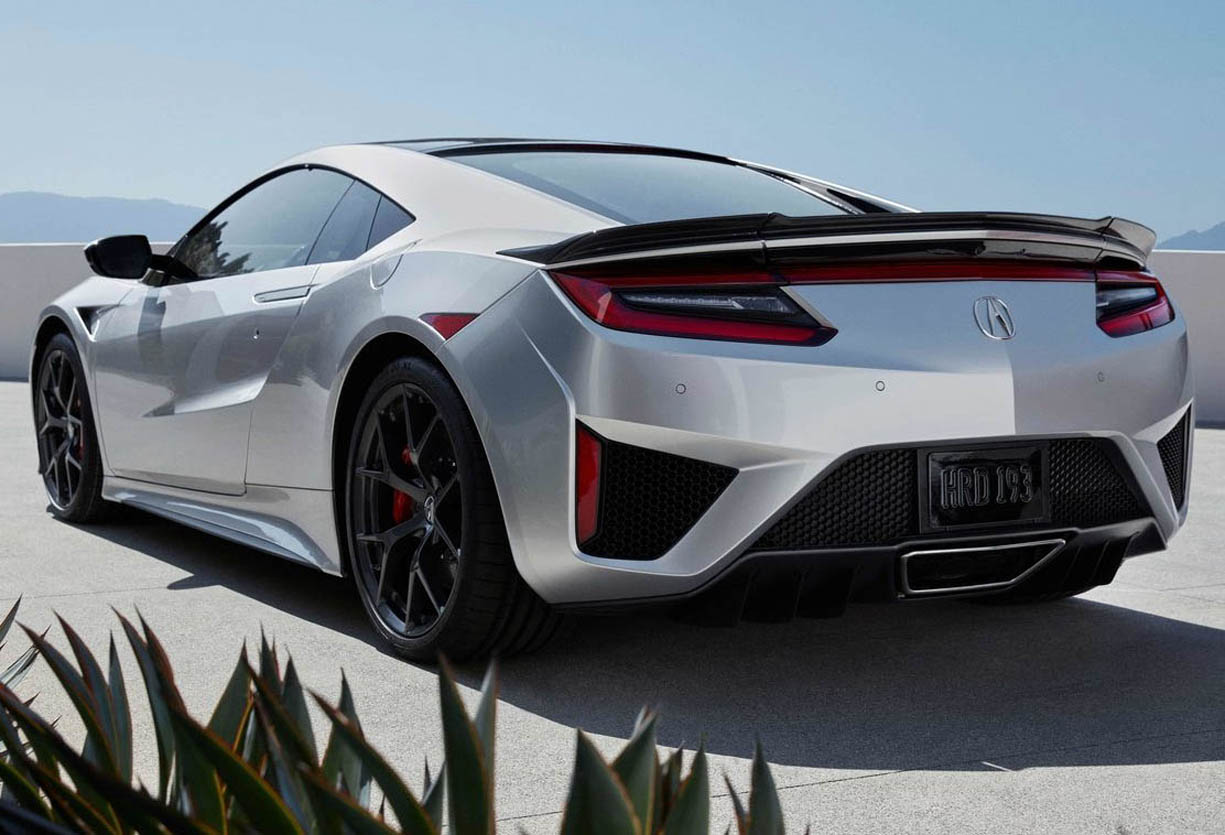
Body panel fitment
Nearing the final step in the vehicle assembly process at the Performance Manufacturing Centre, the exterior body panels are attached to the vehicle’s spaceframe, starting with the roof, then the doors and so on, working from the top down. This process, along with the high degree of dimensional accuracy for the underlying spaceframe, allows for extremely fine adjustment of panels to achieve consistent and symmetrical panel gaps.
Human-centred cabin places an uncompromising focus on the driver
A complementary and essential component of the New Sports eXperience is the driver-centred interior, where every element – materials, shapes, technology and layout – is optimised to enhance the driving experience. Exceptional ergonomics, a hallmark of the original NSX, have been advanced in the next-generation NSX. Moreover, as the pinnacle of Honda’s craftsmanship, the NSX is designed to provide exceptional comfort, outstanding quality and advanced and intuitive technologies, all presented in a clean and modern aesthetic.
From its minimalistic yet contemporary design to its artfully sculpted and ergonomic seats that are enhanced with supportive yet comfortable bolstering as well as high-grade materials, the interior is centred around the occupants and enhances the driver and passenger experience. Strategically placed console and door padding further elevates the level of driver and passenger lateral support.
“The interior of the all-new NSX is highlighted by what we call ‘Interwoven Dynamic’ design,” said Michael Cao, Interior Project Leader. “It combines the best attributes of intuitive, easy-to-use functionality and superior ergonomics with a clean and modern design aesthetic worthy of a next-generation supercar. It’s the ultimate testimony to the beautiful simplicity of form following function.”
Materials such as leather and Alcantara® were carefully selected for the ideal combination of craftsmanship and dynamic driving support. Critical areas of driver contact are appropriately padded to enhance driving support, particularly helpful in spirited driving. The driver’s instrument cluster and centre console have been designed to enhance the driving experience with intuitive layout and simple operation, creating a “simple sports interface” for the driver.
The next-generation NSX interior also supports the idea of a customisable driving experience, employing three advanced sound modulation technologies – Active Sound Control, Intake Sound Control and Active Exhaust Valve – that work in conjunction with the NSX’s Integrated Dynamics System to deliver a tuneable cabin sound experience that reflects driver preference and the driving environment.
Visibility
Continuing the philosophy of the original NSX, Honda’s engineers utilised new technologies to ensure optimum visibility for the driver. The all-new NSX employs a new technology – three-dimensionally-bent and quenched ultra-high tensile strength steel – to create highly rigid yet very thin A-pillars that provide exceptional strength and roof-crush protection while presenting occupants with a comprehensive view of the road ahead. The new A-pillars are even thinner than those on the original NSX.
In addition to the tremendous degree of visibility offered by the streamlined A-pillar construction, the NSX’s interior ergonomics design team minimised the height of the instrument panel and instrument binnacle for enhanced forward visibility.
Interior illumination
The driver’s gauge cluster and Display Audio touchscreen, on the upper portion of the centre console, illuminate upon vehicle entry and progressively brighten to full strength with the start of the power unit. The display screen of the instrument binnacle presents a rich and brightly coloured typeface with information that is easy to read against a black background.
Additional interior lighting includes blue-tinted LED lighting for the foot wells and centre console and twin LED map lights located in the overhead console.
Sport seats
Superbly supportive for higher speed driving on the road or track, while offering everyday comfort, the NSX sport seats were developed with exemplary ergonomics.
In order to maximise driver support and comfort, the four-way manually adjustable driver and passenger seats include tall bolsters with integrated support structures for improved lateral hold, as well as an appropriate balance of ingress and egress and freedom of shoulder movement. The Alcantara centre panels in the seat bottom and seatback enhance lateral grip, while the leather outer surfaces improve ease of ingress and egress.
The seat base structure is composed of stamped aluminium for reduced weight. Both the seat and seatback are of sturdy construction to hold the driver and passenger in place, and for improved longevity and safety considerations. The headrest is designed to accommodate a helmet for track outings.
To facilitate ease of ingress and egress, the optional electrically-powered driver’s seat automatically moves rearward when the ignition is turned off.
Steering wheel
As a primary touch point for the dynamic driving experience, the NSX’s steering wheel has been painstakingly designed to provide a seamless connection between the car and driver, providing superior grip, comfort and control.
The interior frame of the steering wheel is composed of magnesium for strength and low mass, while the leather wrapped outer surface is crafted to be entirely seamless. Ergonomically designed shapes provide optimum grip, control and comfort – the wheel shape optimally supports both nine and three o’clock and ten and two o’clock hand positions, complemented by extended-length paddle shifters. A flattened top section offers improved forward visibility and a flattened bottom section enhances driver leg space, while a manual tilt steering column allows for further driver comfort.
Steering wheel-mounted controls put critical features and functions at the driver’s fingertips. On the left side are the audio volume wheel and source selection button as well as phone controls; to the right are the Multi-Information Display (MID) controls and cruise control functions.
Intake Sound Control and Active Exhaust Valve
The NSX features a new Intake Sound Control (ISC) system and Active Exhaust Valve (AEV) system to create a customisable auditory experience both inside and outside the vehicle.
ISC utilises a pipe – connected directly to the engine’s intake manifold with an electrically operated butterfly valve controlled by the Integrated Dynamics System setting – and a diaphragm that translates high pressure air from the manifold into lower-pressure sound waves. On the other side of the diaphragm, the single pipe then splits into two pipes that transmit sound to twin outlets in the rear uppermost portions of the cabin. Sound transmission and effect are varied according to the four driving modes of the Integrated Dynamics System (Quiet, Sport, Sport+ and Track) – with a high 25 decibels sound pressure level range between Quiet and Track modes.
The AEV system modulates the exhaust note through the use of dual exhaust paths and electrically actuated valve control. Although the exhaust sound is not directly fed to the interior, AEV modifies the engine exhaust note in accordance with the four IDS modes and operates as a complimentary component of the NSX’s customisable auditory experience. The AEV opens all the way at higher engine speeds or under heavy throttle in Sport, Sport+ and Track modes.

Active Sound Control
Active Sound Control (ASC) is utilised to tune the quality and level of cabin sound precisely through dual overhead microphones, an electronic processor, and the audio system’s speakers. ASC operates whenever the engine is running, even if the audio system is turned off.
Working together, ASC and ISC improve the engine sound quality by making the sound pressure level more linear as the engine revs increase, helping smooth out the engine sound by creating a same-phase or reverse-phase sound signal as needed and sending it to the speakers.
ASC is part of the NSX’s Integrated Dynamics System (IDS). When the IDS is in Quiet mode, the ASC system is tuned for a smooth, unobtrusive engine sound. When the IDS is switched to Sport, Sport+ or Track modes, the NSX’s engine sound takes on a more aggressive note.
Instrument panel and centre console
The NSX instrument panel utilises contemporary styling, free flowing curves, authentic refined materials and surface textures to present the easy-to-use and ergonomically designed systems that make up the simple sports interface. The aim is for the driver instrumentation and centre console to offer intuitive and stress-free operation and functionality.
Visually, a clean and minimalist design is presented across the entire instrument panel. Uncluttered with easy access to controls for all primary systems, including the 7.0-inch Honda CONNECT touchscreen, both the instrument panel and centre console feature hand-crafted materials. Selected materials include genuine leather for the instrument panel, Alcantara across the top of the driver’s gauge binnacle, with additional Alcantara trimming for the centre console and glovebox. Furthermore, the critical surface of the centre console and doors that envelope the driver and passenger have been specified with additional padding for optimal knee and elbow comfort and support.
Dynamic Thin-Film Transistor (TFT) gauge cluster
Front and centre of the instrument panel is an 8.0-inch Dynamic Thin-Film Transistor (TFT) display, which is overlaid with a digitally represented analogue tachometer dial. Within the tachometer is the digital speedometer readout and full-colour Multi-Information Display (MID). The central TFT display is flanked by digital gauges displaying the Sport Hybrid SH-AWD system motors’ state of charge or assist (to the left) and battery state of charge (to the right), with an analogue engine coolant temperature gauge on the left and fuel gauge to the right.
The display is linked to the Integrated Dynamics System to provide a visual compliment to the customisable dynamic and auditory elements of the driving experience. In Quiet mode, the display glows a cool blue. In Sport mode, the display takes on a grey hue with red highlights. In Sport+ and Track modes, the tachometer adopts a yellow hue with red highlights and the tachometer rotates to place the lower and upper limits of the tachometer at the six o’clock and three o’clock positions, respectively.
As engine speed increases when driving, the outer ring of the tachometer will flash red once the engine speed exceeds 7,000 rpm to alert the driver to the approaching 7,500 rpm redline. Also, when a new Integrated Dynamics System mode is selected, the MID displays a graphic representation of Integrated Dynamics System component systems – powertrain, SH-AWD, VSA, suspension and steering.
Multi-Information Display
The customisable Multi-Information Display (MID) displays a wide variety of information, controlled by a thumb dial on the right side of the steering wheel. The MID also displays alerts for upcoming maintenance needs. Should a fault occur, specific warning information will appear on the MID. MID information categories include:
- Integrated Dynamics System mode
- Elapsed time
- Average speed
- Average fuel economy
- Instant fuel economy
- Estimated fuel range
- Maintenance
- Tyre pressure monitoring system (TPMS)
- Turn-by-turn navigation (where specified)
- Turn-by-turn navigation for integrated Apple CarPlay® and Android Auto™
The TFT gauge cluster relays important information to the driver relating to the current state of transmission operation in a clear and concise graphical format, depending on the transmission’s mode of operation. ‘Auto’ signifies that the car is currently in automatic mode, while ‘D-Paddle’ signals that although Auto is still selected, the car is in a temporary manual mode, with the driver manually selecting gears via the steering wheel-mounted paddle shifters. The display returns to Auto when manual shift activity stops for a certain period of time. ‘Manual’ displays only the gear selected when the car is in fully manual mode.
Centre console
An integral part of the NSX’s elegantly simple driver interface, the centre console contains the 7.0-inch capacitive touchscreen Honda CONNECT system, Dual-Zone Climate Control, the Integrated Dynamics System control knob, three-position heated seat controls, Electronic Gear Selector, Electronic Parking Brake and two storage compartments.
Dual-zone automatic climate control system with humidity control and air filtration
The system allows both driver and passenger to pre-select their preferred temperature settings, and then automatically adjusts volumetric airflow and temperature to maintain a proper and pleasant climate within the vehicle.
Push-button defrost helps to clear up fogged or icy windows quickly and conveniently for improved outward visibility. By maintaining a proper and comfortable climate, the system supports occupant concentration for improved safety as well as driving performance.
With a micron air filtration system, the dual-zone automatic climate control system is capable of filtering particulate as small as 0.3 microns. Humidity control further improves the vehicle’s interior air quality and comfort levels by using a sensor within the cabin to detect temperature and moisture levels and regulating airflow to maintain a comfortable humidity level.
Integrated Dynamics System: dynamic mode dial
Located within easy reach of the driver, the large dynamic mode dial allows a drive mode to be selected from the Integrated Dynamics System without any distraction from the road ahead.
Electronic Parking Brake with Automatic Brake Hold
An Electronic Parking Brake (EPB) allows the driver to engage the parking brake by simply pulling on a rocker switch located on the centre console.
The EPB also includes the convenience of Automatic Brake Hold (ABH), which once activated, can maintain rear brake hold even after the brake pedal has been released. With the driver’s seatbelt on and the vehicle in Drive with a foot on the brake pedal, ABH can be initiated by pressing the Brake Hold button located near the EPB rocker switch on the centre console. A ‘Brake Hold’ message will appear on the instrument panel to alert the driver that the system is currently activated. The brake pedal can be released and the vehicle will remain stationary; pressing down on the throttle pedal will deactivate the brake hold feature and the vehicle will start moving.
Interior storage
A number of convenient storage areas are provided for both driver and passenger. At the base of the centre console is an inset front pocket. An additional storage pocket located along the top of the centre console between the seats is designed to accommodate a smartphone. The centre console also includes a roomy rear console storage box that contains a 1.5-amp USB interface port that can synchronise a smartphone to the Honda CONNECT touchscreen for operation of Apple CarPlay and Android Auto. A phone cord management device is also located underneath the rubber mat that lines the bottom of the glovebox.
Additional storage is offered by the glovebox, which also includes a 1.0-amp USB interface port that can be used for audio devices such as MP3 players.
Rear cargo area
The rear cargo area is exceptionally spacious and versatile for a mid-engine high-performance supercar. With a capacity of 110 litres, the boot can conveniently accommodate a range of items, all easily accessed through a wide opening. The boot lid can be opened using the remote key fob, a button located on the driver’s interior door or by depressing a discretely located button under the trailing edge of the boot lid.
Audio and Connectivity
An advanced, user-friendly suite of audio and connectivity technologies are controlled by a 7.0-inch Honda CONNECT capacitive touchscreen interface with intuitive touch, swipe and tap control motions. The Honda CONNECT system is supplemented by steering-wheel-mounted controls to put access to features and functions at the driver’s fingertips.
Premium audio system
The bespoke nine-speaker 580-watt ELS Studio® Premium Audio system with eight speakers and a powerful subwoofer has been engineered to be lighter than comparable systems. Portable electronic devices can be connected to the system wirelessly via the Bluetooth HandsFreeLink, or hard-wired through the USB input ports.
Honda CONNECT touchscreen
The seven-inch Honda CONNECT touchscreen is capable of displaying rich graphics and allows the high-resolution touchscreen to be operated in an identical fashion to a smartphone through tap, pinch and swipe user inputs.
Intuitive operation of the system is ensured thanks to an easy-to-use menu interface and numerous NSX-exclusive icons that resemble smartphone apps. Both Apple CarPlay and Android Auto are supported by the system. The Honda CONNECT touchscreen also displays images from the standard-fit rear view camera.
Customers can choose to upgrade the Honda CONNECT system with an option pack that includes Garmin navigation, CD player and front and rear parking sensors.
Apple CarPlay
Apple CarPlay allows apps within an iPhone to work seamlessly within the Honda CONNECT system. CarPlay turns the native in-car control system into an Apple iOS device, allowing the driver to use their iPhone within the car by utilising the Honda CONNECT touchscreen. Intuitive operation is assured as the icons and graphics that appear on the Honda CONNECT system touchscreen are identical in appearance to the iPhone apps when using CarPlay.
When using the navigation feature, turn-by-turn directions, continuously updated traffic conditions and estimated travel time are displayed on the Honda CONNECT system’s touchscreen. While using the navigation feature, CarPlay can also predict the most likely destinations using addresses from email, text messages, contacts and calendars.
For improved safety, CarPlay makes use of the hands-free voice operation features of Siri. Playing a key role to support Apple CarPlay, Siri Eyes Free builds upon Apple’s hands-free Siri functionality by enabling voice control operation of an Apple iOS mobile device that is linked with the Honda CONNECT system. Siri Eyes Free provides a virtually limitless array of voice commands, taking Siri’s hands-free functionality to a new level while simultaneously minimising the potential for distraction.
Using the Siri hands-free voice control functionality or pressing a familiar icon on the Honda CONNECT system touchscreen accesses a number of convenient CarPlay features. These include navigation, reading aloud and replying to text messages, listening to music, radio station apps, podcasts or audiobooks.
By pressing and holding the TALK button on the steering wheel when an iPhone is paired via Bluetooth, the driver can use Siri to perform a number of tasks while keeping both hands on the steering wheel and maintaining focus on the road. Siri Eyes Free can:
- Audibly send and receive text messages
- Audibly send and receive emails
- Audibly receive notifications
- Make and receive calls
- Select and play music
- Set up reminders, alarms and calendar entries
- Check sports scores, weather and stock quotes
- Provide turn-by-turn voice navigation (when the audio system is set to Bluetooth audio or iPod mode)
Android Auto
Android Auto integrates compatible Android smartphones with the Honda CONNECT system. A customised version of an Android smartphone is transferred onto the Honda CONNECT touchscreen when it is plugged into the car’s USB port in the centre console rear storage box. Once plugged in, all phone calls are handled via the NSX’s Bluetooth connectivity.
Android Auto allows inputs to be made by tapping and swiping the Honda CONNECT system’s touchscreen or by making simple voice commands. Once connected with the vehicle, access is provided to Google Maps, Google Now and Google Play Music, along with a variety of popular third-party Android-compatible music apps and a wide array of sports, financial, weather and media information apps. There is also an Android Auto messaging app that will flash a notification of an incoming message on the Honda CONNECT touchscreen, read the message aloud, and allow a reply by voice.
Bluetooth HandsFreeLink
Bluetooth HandsFreeLink allows up to six Bluetooth-enabled phones to be wirelessly paired with the Honda CONNECT system. Complementing the HandsFreeLink system is Bluetooth Streaming Audio, a hands-free in-car system which allows the audio feature of a compatible Bluetooth-enabled device such as a smart phone or MP3 player to be paired wirelessly with the audio system. Music, podcasts, and audio books can be streamed wirelessly to the NSX’s sound system. Certain compatible devices will even display metadata of the musical artist, album and song title on the Honda CONNECT touchscreen.
Text messages and emails can be audibly read aloud, with the system allowing the driver to respond with one of six different preset messages. The preset responses include:
- Talk to you later, I’m driving
- I’m running late
- I’m on my way
- Okay
- Yes
- No
As soon as a compatible phone is paired with the HandsFreeLink system, the message function is enabled. When the phone receives a text message, an alert appears on the Honda CONNECT screen. Using the touchscreen, the driver can choose to have the message read aloud, select a preset reply choice, or call the sender without touching the phone. To help mitigate the potential for driver distraction, the text of the incoming message is not displayed on-screen unless the transmission is in Park.
Apple iPhones do not support this feature, but the Siri Eyes Free mode (iPhone 5 and 6) offers the ability to initiate, hear and respond to text messages via voice commands.
USB ports
The centre console storage box features an integrated 1.5-amp USB interface port that connects with Apple CarPlay and Android Auto, as well as the audio system, including the Honda CONNECT touchscreen. Located in the glove box is a 1.0-amp USB interface port with support for iPod, MP3 and other USB functionality.
Advanced occupant protection
Active safety is promoted by stable, precise and predictable driving dynamics, with steering, handling and braking performance providing the foundation for active safety performance and collision avoidance. To provide a high-level of occupant protection in the event of a collision, an advanced multi-material body design is employed along with both primary and supplemental restraint systems. These systems work together to manage effectively the energy in a collision, minimising cabin intrusion and mitigating occupant injury.
The innovative multi-material spaceframe utilises ablation cast aluminium nodes and highly rigid extruded aluminium frame members for superior crash protection and occupant protection with light weight and high rigidity. The world’s first application of a three-dimensionally formed and water jet-quenched ultra-high-strength steel for the A-pillar construction offers robust structural rigidity including roof-crush performance.
Furthermore, the multi-material spaceframe design and the packaging of hybrid components, including the lithium-ion batteries and high-voltage systems, have also been optimised for both occupant protection and the safety of the rescue services.
Standard primary and supplemental restraint systems include single-stage driver and dual-stage passenger multiple-threshold front airbags (SRS), driver knee airbag, SmartVent® side airbags, side curtain airbags with rollover sensor and three-point seatbelts with a load-limited equipped automatic tensioning.
Accompanying these passive safety technologies, an additional level of safety performance is afforded by advanced active and passive safety technologies such as Vehicle Stability Assist (VSA) with traction control, Anti-Lock Braking System (ABS) with Electronic Brake Distribution (EBD) and Brake Assist and the Tyre Pressure Monitoring System (TPMS) with location and pressure indicators.
Vehicle Stability Assist with traction control
The system operates to correct or minimise traction loss prior to it occurring by continually monitoring key dynamic parameters and driver inputs such as steering angle, throttle position, yaw rate, lateral G-force, vehicle speed, and individual wheel speeds. If an oversteer or understeer condition is recognised, the VSA – working in conjunction with the Sport Hybrid SH-AWD system and the power unit – is able to instantaneously and unobtrusively redirect torque and invoke the ABS braking system at each wheel as needed to help stabilise the vehicle. The system also increases traction and reduces wheel spin in conditions with reduced grip, such as wet, icy or snowy conditions.
Developed through extensive testing on both road and track, the vehicle stability system is highly effective while minimising intrusion on the driving experience. In most instances, the VSA response is quick and seamless. VSA is fully functional in Quiet, Sport and Sport+ modes of the Integrated Dynamics System, but its dynamic performance is tuned accordingly. In Track mode, VSA is programmed to support on-the-limit circuit driving.
Tyre Pressure Monitoring System with location and pressure indicators
The Tyre Pressure Monitoring System (TPMS) displays the current tyre pressure of each individual tyre in a visual graphic shown on the centre display (in the Multi-Information Display), representing an important safety feature for an ultra-high-performance supercar. The TPMS has different settings for both low- and high-speed operation, as circuit driving requires an elevated tyre pressure.
Multi-material spaceframe
The aluminium-intensive multi-material spaceframe utilises a combination of materials throughout the platform for high strength and rigidity in the event of a collision. The spaceframe construction consists of highly rigid aluminium extrusions, aluminium stampings, high-strength steel stampings, and ablation cast aluminium frame nodes – integrated with the front and rear frame rails – which serve as critical components in the absorption and dispersion of energy in both front and rear impacts.
Ablation cast nodes
Ablation cast nodes have been fitted at key junctures within the front of the spaceframe to help optimise impact protection for the vehicle’s occupants in the event of a collision. Ablation cast nodes help to minimise overall vehicle weight while offering superior strength and tremendous ductility to facilitate energy absorption in a collision. An added benefit in the ablation casting process is the flexibility to tune the component’s wall thickness for optimal weight, strength and deformability.
The spaceframe’s front nodes are designed to deform and in the process to absorb energy in a frontal collision, helping to minimise the transfer of kinetic energy to the cabin. Additionally, two ablation cast nodes in the rear frame are designed for ultimate rigidity to transfer crash energy into the extruded aluminium rear frame rails in order to mitigate the potential for forward movement of the rear power unit in the event of a rear collision.
Optimised packaging
A twin-tank design enhances safety performance in the event of a rear-end collision. By using a twin-tank configuration and specialised resin material, the fuel tanks can be packaged in the safest location possible, between the rear firewall and the power unit.
The Intelligent Power Unit (IPU), containing the vehicle’s lithium-ion hybrid battery, is strategically packaged inside the cabin, in front of the rear firewall, optimising protection in the event of a frontal or rear collision. Furthermore, the location helps protect the IPU from damage in a side impact by the use of highly rigid B-pillars. In testing the performance of this system, a simulated side impact ‘pole’ test was undertaken with the impact occurring directly on the B-pillar. The test resulted in no damage to the IPU.
Advanced Sports Package and innovative technologies provide astonishing dynamic performance
The NSX was created to revolutionise supercar performance, delivering a more vivid, immediate and intuitive dynamic experience with instant acceleration, powerful yet easily controlled brakes, and exceptional handling. Every aspect of the car has been designed using the company’s latest simulation and development techniques to deliver a New Sports eXperience.
The NSX’s dynamic performance follows a tradition of sophisticated engineering and advanced design, providing a combination of assured handling performance, sophisticated ride quality and overall refinement that set new standards in the supercar segment.
Unparalleled structural rigidity transmits the full feeling of the power unit, suspension, and steering directly to the driver with instant response, while maximising the effectiveness of direct yaw control to improve vehicle dynamics. The ‘Advanced Sports Package’ prioritises the design and packaging of all major vehicle systems to lower and centre the mass of the vehicle for enhanced handling and dynamic performance.
Advanced lightweight suspension and steering systems are carefully calibrated to work with both road and track-ready tyre options, as are all other dynamic systems. Optimised front-to-rear downforce balance ensures high speed handling stability while ensuring low aerodynamic drag.
Sport Hybrid SH-AWD provides active all-wheel drive and enhanced handling capability via the dynamic apportioning of the TMU’s torque. The ‘direct yaw control’ of this electrified torque vectoring system creates a yaw moment under any driving condition, to achieve the driver’s desired cornering line. An instant and powerful feeling of acceleration is enhanced by the immediate torque response of three electric motors working in concert with the bespoke, twin-turbocharged V6 and 9DCT.
Powerful, linear, predictable and virtually fade-free braking performance in all driving conditions is achieved through the seamless integration of high-performance mechanical (Brembo hydraulic) and regenerative braking.
Low and centred mass
The ‘Advanced Sports Package’ is a design philosophy that seeks to optimise the design and packaging of all major vehicle systems – the body, chassis and interior, including the mid-mounted power unit (engine, Direct Drive Motor and 9DCT) and key hybrid components including the IPU (which contains the lithium-ion battery pack), PDU and the TMU – to lower and centre the mass of the vehicle for optimal handling and dynamic response. The new NSX has the lowest centre of gravity (CG) among its core competitors.
Focusing the mass toward the centre of the NSX reduces the polar moment of inertia, allowing the car to respond faster to steering inputs through a reduction in rotational resistance. The low CG reduces the dynamic load transfer, thus stabilising the vertical load on the tyres.
This results in instant and precise response to driver inputs, minimal unwanted body movement and a stable tyre grip, which raise performance levels.
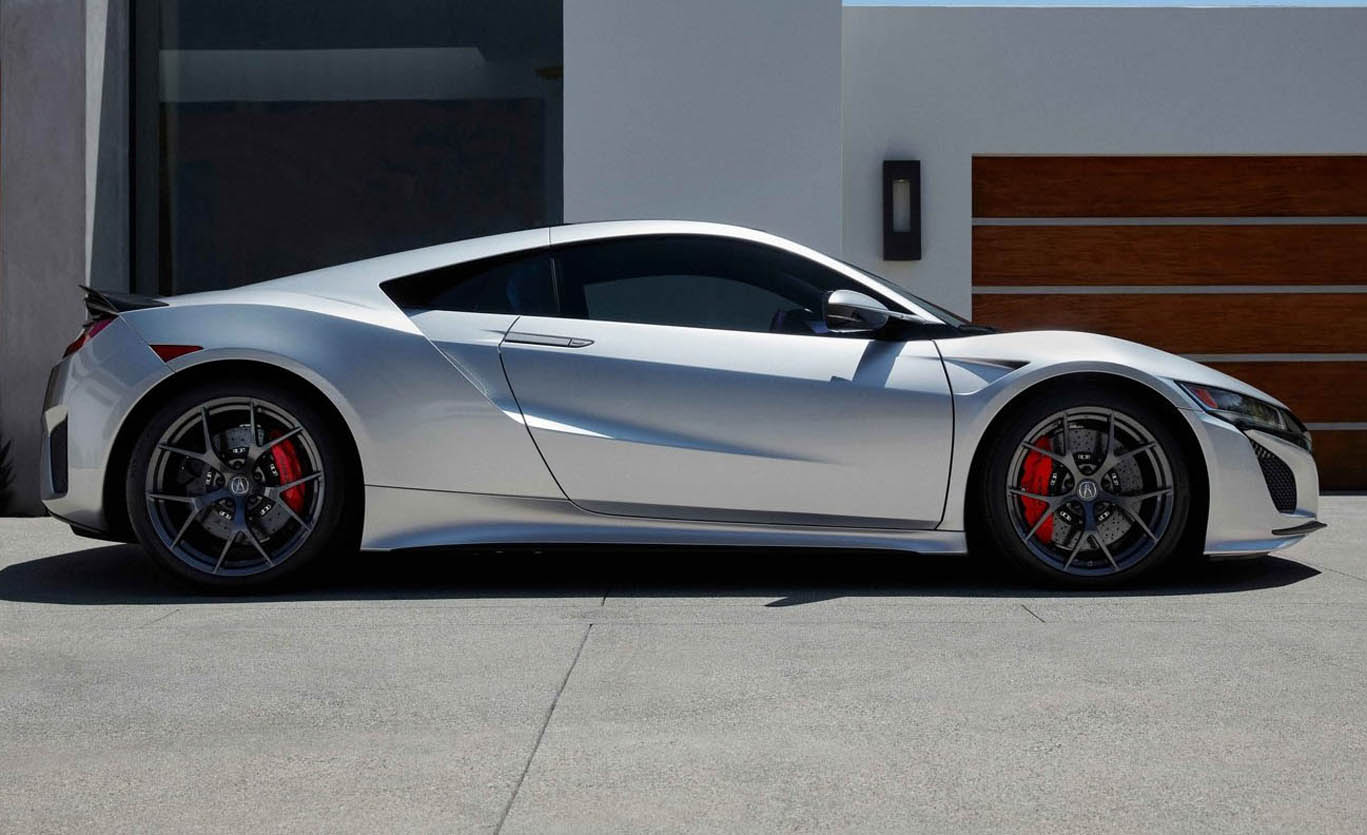
Power unit mounting system
In order to achieve outstanding dynamic properties while producing the lowest levels of noise and vibration, special consideration was given to how the power unit – engine, Direct Drive Motor, 9DCT and differential – is secured to the chassis.
An engine cradle system was designed combining hydraulic engine mounts with a rigid aluminium sub-frame plate that simultaneously supports the engine while acting as a vibration and noise inhibitor. The engine mounts are ideally located with an axis that passes through its centre of gravity to minimise pitch and roll movement of the engine mass. Testing and analysis demonstrated that this novel configuration provides notably improved vehicle handling performance while exceeding targeted noise, vibration and harshness (NVH) levels.
Suspension
The front double wishbone and rear multi-link suspension systems support the extreme dynamic needs of the NSX and are designed to work in perfect harmony with every system, specifically the Sport Hybrid SH-AWD. The system maintains the precise geometry to extract the maximum grip and control from the tyres. Agile at low speeds, yet supremely stable and predictable at high speeds, the suspension faithfully translates the driver’s inputs for ultimate handling performance and instant response.
Much like the original NSX, the next-generation NSX utilises a lightweight all-aluminium, fully independent front and rear suspension system. Featuring lightweight yet rigid aluminium alloy components at all four corners, the suspension keeps unsprung weight to a minimum while retaining component stiffness for instant and accurate response. Designed to work seamlessly with the advanced electric power steering system, the optimised tuning of the steering and suspension systems allows for both instant responses at low speeds, coupled with superlative high-speed stability.
The all-aluminium front suspension’s ‘in-wheel’ design makes use of compact and lightweight components, such as forged aluminium double wishbones with a cast aluminium knuckle design. An advanced double-joint front suspension design mitigates torque disturbance from the front TMU torque vectoring and eliminates unwanted steering kickback. The suspension geometry delivers superior handling performance, crisp and communicative on-centre steering feel and excellent stability.
The rear suspension employs a sophisticated independent, all-aluminium, forged ‘in-wheel’ multi-link design for high lateral rigidity, faithfully reacting to driver inputs and maintaining stability.
Active magnetorheological dampers
Through third-generation magnetorheological (MR) dampers, the NSX’s highly advanced suspension can continuously adjust damping forces in a fraction of a second, instantaneously adapting to the driving situation, driver inputs and road conditions.
The third-generation technology offers a wider range of damping force and instant response for maximum handling capability and ride quality in all driving conditions. The reservoir within each of the MR dampers is filled with a special magnetorheological fluid that contains microscopic metallic particulate. Running an electric current to each MR damper creates a magnetic field within the fluid that causes an instantaneous change in the fluid’s density properties with a resulting change in damping rate.
While many active dampers make use of an internal valve-based technology to vary the damping force, the NSX’s MR dampers utilise a valve-less design that offers a much broader range of damping force and more rapid responsiveness.
In addition to their lightning-quick response rate and superior damping properties, MR dampers allow the NSX to make optimum use of a high-performance tyre design and low-profile sidewall while still providing a comfortable ride.
The MR dampers also function as a component of Integrated Dynamics System via two unique damper tuning settings – one biased towards unsprung mass control, used for Quiet and Sport modes; and a second with optimised performance tuning, biased towards sprung mass control, used for Sport+ and Track modes.
Wheels and tyres
A bespoke wheel and tyre package extracts optimal performance from the platform, not only in lateral grip but in every element of driving performance, including acceleration and braking.
The standard wheel design package includes lightweight and exclusive ‘Interwoven’ forged aluminium alloy wheels with Continental ContiSport Contact high performance summer tyres (245 / 35 ZR19 at the front, 305 / 30 ZR20 at the rear), developed jointly with Continental specifically for the NSX. The tyre package strikes an excellent balance between high performance and everyday drivability, offering high levels of traction in both wet and dry conditions
The unique ‘Interwoven’ wheel design is a result of extensive research to find the strongest and most rigid spoke structure with the least amount of material. Forged in high-strength aluminium, the optimisation of wheel design offers a lower total weight than any wheels of similar size and material composition within the class. Customers have the choice of one of three finishes: machined, polished or painted.
Intuitive steering
A sophisticated dual-pinion electric power steering (EPS) system responds instantaneously to steering input and automatically adjusts to deliver the appropriate level of power assist in all driving situations.
“It was a huge challenge to create a lively and communicative electric power steering for the driver that would be truly worthy of a next-generation Honda NSX,” said Chris Dundon, chassis design project leader. “But by optimising the mechanical components within the system, plus careful tuning of the software, we were able to achieve our goal of delivering highly responsive steering with outstanding driver feel.”
Reduced weight and improved packaging was achieved through compactness and a reduction in the number of required components over a hydraulic system. Redundant elements include hydraulic fluid, pump, fluid storage tank, hydraulic fluid lines and hoses. An electric system also reduces levels of noise and vibration, and enhances fuel efficiency with no parasitic drag from an engine-driven power steering pump.
A variable gear ratio allows the EPS to be optimised for specific conditions. When the steering wheel is centred, the ratio is tuned for optimal high-speed control and stability. As soon as the steering wheel is turned, the gear ratio becomes quicker for improved turn-in and manoeuvrability at low and mid-range speeds. A further benefit is the reduced need for the driver’s hands to be moved from a fixed position on the steering wheel.
The addition of a motor-assisted second pinion to the EPS system more precisely assists with turning force and steering assistance based on a number of factors – engine speed, electric motor torque from the Sport Hybrid power unit, steering angle, vehicle speed, steering force and EPS algorithms – and leads to improved steering feel and feedback for the driver.
The EPS features two distinct EPS steering settings; one for Quiet and Sport modes, the other for Sport+ or Track modes. Selected through the Integrated Dynamics System in concert with the MR damper suspension system, the EPS tuning is adjusted to deliver an increased level of acuity and performance for an even greater degree of driver feedback by reducing steering assist based on vehicle speed and steering angle for the more performance-oriented Sport+ and Track modes.
Sport Hybrid Super Handling All-Wheel Drive
The revolutionary Sport Hybrid SH-AWD advances the principles of torque vectoring-enhanced vehicle dynamics with ‘Direct Yaw Control’. Direct Yaw Control utilises the instantaneous and ‘always-on’ capacities of the TMU to create a direct yaw moment at any speed, under power, and in off-throttle driving manoeuvres with greater immediacy and precision.
Supported by the advanced yaw-control capabilities of Sport Hybrid SH-AWD, the NSX is able to achieve enhanced stability with reduced effort. This technology expands the capabilities of all drivers, ranging from novices to professionals in virtually all driving scenarios
When accelerating, the system provides instantaneous torque response via its three electric motors – the Direct Drive Motor and front TMU. While braking, the NSX employs both the hydraulically powered mechanical braking system and the regenerative braking system to deliver powerful, precise and virtually fade-free brake performance with a natural and progressive pedal feel. Simultaneously, the system is able to harvest kinetic energy to charge the system’s lithium-ion hybrid battery.
When cornering, the TMU and VSA work cooperatively to enhance cornering precision. The TMU dynamically vectors front wheel torque to create a turning, or yaw, moment with enhanced stability provided by VSA and AHA.
By taking advantage of the instant high-torque response of the system’s three electric motors to heighten control, the Sport Hybrid SH-AWD system elevates any driver’s confidence and performance driving capabilities while extracting more performance from the car than is possible with conventional methods.
Powerful and responsive powertrain
Power delivery is created through the seamless integration of the instant and substantial torque from the front TMU and Direct Drive Motor with the twin-turbo 3.5-litre V6 engine. Importantly, the NSX’s control systems manage the collective system power and torque smoothly while allowing almost instantaneous response and acceleration.
The 9DCT is capable of delivering up- and downshifts almost seamlessly. The total ratio range with closely spaced ratios supports the characteristics of the twin-turbo V6. The 9DCT can be operated in an automatic mode, with the transmission selecting the most appropriate ratio, or manually through steering wheel-mounted paddles.
Launch Mode Control
To activate Launch Mode Control, the 9DCT must be set in either Drive or Manual, with the Integrated Dynamics System set to Track mode. The brake pedal must be held down while the accelerator is simultaneously depressed fully. When the brake pedal is released, the NSX will perform a perfectly executed vehicle launch that utilises peak power from the TMU, the twin-turbocharged V6 engine and Direct Drive Motor.
Next-Generation Super Sports Brakes
Seamlessly integrating both mechanical (friction) brakes with electro-servo control and a regenerative brake system, the NSX provides exceptional brake pedal response and predictable performance in almost any driving condition.
By supplementing the high-performance mechanical braking system with regenerative braking, the NSX harvests electricity during braking and feeds it back into the lithium-ion battery pack. Regenerative braking begins as soon as the throttle pedal is released in order to maximise battery recharging during normal driving. Unlike many such systems, the NSX blends this capability in a seamless and effective way, resulting in intuitive brake pedal feel with superb feedback.
The electro-servo braking system (ESB) has been designed and developed through rigorous testing to provide the driver with superb feedback and intuitive brake pedal feel in all conditions. This allows drivers to finely modulate braking force in any condition – from low speed city traffic, to circuit driving.
The high degree of brake pedal feel is achieved through precise pressure control by the electric servo brake (ESB). The operation of the ESB is then finely tuned to deliver consistent and proper brake pedal feel for each of the drive mode settings of the Integrated Dynamic System (IDS).
Importantly, the brake pedal feel remains consistent and predictable across the four different drive mode settings of the IDS.
The high-performance Brembo braking system features large six-piston calipers with 368 mm, two-piece, iron and aluminium ventilated brake discs at the front, and four-piston calipers with 361 mm, two-piece, iron and aluminium ventilated rotors at the rear. All four calipers are of an aluminium monoblock design, which provides even pressure distribution across the surface of the brake disc with outstanding heat dissipation and excellent rigidity. The two-piece iron and aluminium brake discs provide consistent brake pad-to-rotor surface contact with high heat capacity and cooling efficiency. Additionally, this floating two-piece brake disc configuration allows for much greater thermal expansion when compared to a one-piece brake disc.
An ultra-high-performance and lightweight carbon ceramic brake disc package (381 mm at the front, 361 mm at the rear) is available as a factory option. This offers a reduction in weight of around 23.5 kg when compared to the standard brake package together with improved fade performance in high stress conditions.
Through extensive research and development, optimal brake cooling has been achieved as an integral part of the NSX’s advanced aerodynamic design. Even under the high stress conditions, front and rear brake cooling always promotes consistent deceleration capability, brake pedal feel and superb vehicle stability.
Typically, effective brake cooling at the rear of a mid-engine vehicle is difficult due to component packaging, and the proximity of the engine and transmission. Rear brake cooling on the NSX is enhanced by the innovative use of the NSX’s rear sub-frame. Two air duct paths in the hollow sub-frame allow air passing through the sub-frame to be directed to the rear brakes, using specially tuned air deflectors located on the rear suspension arms.
Integrated Dynamics System
The Integrated Dynamics System provides the driver with four dynamic modes: Quiet, Sport, Sport+ and Track. The system integrates all of the vehicle’s dynamic chassis and powertrain systems to give the driver control of steering, brakes (including regenerative braking), throttle, vehicle stability assist, magnetorheological dampers, engine, transmission, and Sport Hybrid SH-AWD power unit.
From the available all-electric operation of Quiet mode to the closed circuit, maximum performance capacities of Track mode, the Integrated Dynamics System progressively dials up the dynamic characteristics of the NSX based on the needs of the driver and the driving environment.
Each of the IDS system’s four modes can be accessed at any time via a control dial prominently placed on the centre console. In addition, the system features a custom setting menu, accessible through the touch-screen interface, which allows the driver to configure the vehicle’s default mode. For example, the car can be programmed always to start in Quiet or Sport mode, while the system also presents the option to schedule the NSX to operate exclusively in Quiet mode during any specified time period.
In addition to these dynamic system variations, IDS also varies cabin sounds.
Quiet
Quiet mode prioritises electric-only driving at lower speeds, maximising energy efficiency and minimising cabin sound. The TMU is used for the initial launch from a standstill. When power demand requires the engine, it starts more quietly than in other modes and the maximum engine speed is limited to 4,000 rpm, while the Active Exhaust and Intake Sound Control valves are closed for a more hushed operation. The transmission shift map also prioritises lower engine speeds, while the idle stop function is enabled when the engine is in operation. The instrument binnacle displays a cool and quiet blue colour.
Sport
Sport mode takes advantage of the Sport Hybrid system to offer the driver a more direct response. Compared to Quiet mode, the 4,000 rpm limit is removed and a sharper throttle map is applied. A more aggressive transmission shift map holds gears longer and allows gear shifts at higher engine speeds. The Intake Sound Control system and the Active Exhaust Valve are activated, allowing additional exhaust and intake sound to permeate the cabin. Like the Quiet mode, Sport mode provides an idle stop function. The Sport setting is the default setting in normal vehicle operation and is signified by crisp white lighting within the instrument binnacle.
Sport+
Sport+ prioritises maximum drivetrain response and dynamic performance, with faster up- and down-shifts of the 9DCT, complemented by still more aggressive throttle mapping. Full use of electric motor torque allows for explosive acceleration. Increased agility is achieved through a more aggressive Direct Yaw Control setting that works in conjunction with retuned settings for the magnetorheological dampers, Agile Handling Assist, and Electric Power Steering (EPS) system. It also offers the driver a higher degree of steering feedback, while intake and exhaust note sounds via Active Sound Control are further increased for an even more exhilarating and emotional driving experience. The TFT dials display a distinctive yellow arc that follows the tachometer needle to support easy recognition of engine speed. Red highlights for the instrument binnacle also reinforce that the driver is in now in Sport+ mode.
Track
Tuned for circuit driving, Track mode invokes the most aggressive settings and parameters to assist the driver in recording the fastest and most consistent lap times possible, along with maximum acceleration from a standstill when utilising Launch Mode Control. The braking system is retuned to offer enhanced performance-oriented pedal feel. Gearshift speed, operation of the Super Hybrid SH-AWD system and active driver aids such as VSA and AHA are programmed to support on-the-limit circuit driving. An even greater amount of engine intake sound permeates the cabin, offering enhanced sports sound even when wearing a helmet.
Track mode also prioritises the lithium-ion battery state-of-charge to maintain a consistent level of torque delivery and Direct Yaw Control from the three electric motors for consistent dynamic responses.
The VSA operational threshold is ramped up incrementally from Quiet mode to Track mode, enabling a progressively higher degree of freedom for the driver in exploring the dynamic capabilities of the NSX. In Track mode, the VSA can be completely disabled by the driver.
25 years after the original NSX represented a paradigm shift in production techniques, Honda’s next-generation supercar sets new benchmarks
Design and development of the next-generation NSX involved a global team of engineers and designers. The Sport Hybrid power unit was developed in Tochigi, Japan, while the development of the body, chassis, electrical, interior and other vehicle technologies were concentrated in Raymond, Ohio.
Initial styling was conducted at Honda’s Wako, Japan design studio and was further developed for production by the Honda Design Studio in Los Angeles.
Throughout its nearly four-year development, the fundamental concepts for a New Sports eXperience remained clear and consistent. However, the technologies and means by which the R&D team would realise their concept underwent a process of continual improvement and evolution, most notably in the area of engine design. Whereas the original direction called for a transverse-mounted, normally aspirated V6, the NSX development concept evolved to a new and more challenging approach: an all-new bespoke twin-turbocharged, longitudinally-mounted V6 engine. This radical re-imagination of the engine design had profound implications for every element of the design – especially the package, cooling and aerodynamics.
The NSX has been tested and tuned on roads and race circuits around the world. Primary development tracks were located in Alton, Virginia at Virginia International Raceway; in Rhineland, Germany at the famed Nürburgring; and on the northern-most Japan island of Hokkaido at Honda’s own Takasu test circuit.
The NSX is manufactured at the new Performance Manufacturing Centre (PMC) in Marysville, Ohio, using domestic and globally-sourced parts. The PMC was designed to innovate both the means and the methods of producing low-volume specialty cars and to realise challenging new ideas for next-generation craftsmanship and quality established by Honda’s engineers. The Performance Manufacturing Centre employs approximately 100 associates, including 70 highly skilled manufacturing technicians engaged in body construction, painting, assembly and quality confirmation. Among its many innovative processes is the world’s first use of robotic MIG welding for the construction of the aluminium spaceframe.
The bespoke twin-turbocharged V6 engine is meticulously hand assembled by one of just eight expert technicians at the company’s engine plant in Anna, Ohio, using techniques and processes benchmarked against the company’s world-class race engineering programs. Each engine is bench tested and broken in to the equivalent of 150 miles of service. The nine-speed dual clutch transmission, Direct Drive Motor and engine are machine balanced and assembled at the Anna Engine Plant. The Twin Motor Unit (TMU) and other hybrid system components are built in Japan and sent directly to the Performance Manufacturing Centre.



